
*This study is also available in French
Several studies published over the past few years have shown that a considerable number of young children in Quebec risk having their educational trajectories compromised by insufficient behavioural or cognitive maturity. This study by Christa Japel allows us to gain more knowledge about the conditions in which these children grow up and to better understand the links between these and the children’s later adaptation, that is, their cognitive performance and behaviour when they reach prekindergarten and kindergarten age. The author used the Québec Longitudinal Study of Child Development (QLSCD) to trace a detailed portrait of a cohort of children born in 1997 and 1998. The data were collected over seven data points when children were 5 months, 17 months, 29 months, 41 months, 4 years, 5 years and 6 years of age.
Informed by the results of several studies conducted in Canada and other countries, which made it possible to get a coherent picture of the risk factors that can compromise a child’s optimal development and to determine that behaviour and cognitive skills are important predictors of later adaptation, the author examines the connections between the risk factors in the lives of this cohort of Quebec children and their scores on cognitive and behaviour tests. Cognitive performance was measured using vocabulary and numerical tests administered in prekindergarten and kindergarten, while the data on behavioural adaptation are based on information provided annually by the person who best knows the child.
The author thus profiles “at-risk” children and examines the consequences vis-à-vis their behaviour and their cognitive performance. More specifically, she examines the relationship between the number of risk factors in the children’s lives at a given moment and their concomitant adaptation levels. She is also able to determine whether the risk factors that are present at the beginning of the child’s life allow us to predict how the child will adapt in subsequent years. Above all, this study presents a longitudinal perspective and provides the opportunity to examine the links between the number of years that the child is in a situation of risk over the course of his or her early childhood and the indicators of adaptation in prekindergarten and kindergarten. Finally, thanks to detailed information collected about children’s different nonparental care situations, it also allows us to see the extent to which at-risk children use these services and to what extent these services play a protective role for the children.
The results of this study show the following:
On the basis of these results, the author makes several recommendations pertaining to school, preschool and family environments, early detection, and the organization and quality of child care services.
According to a recent study by the Direction de santé publique de Montréal (Montreal Public Health Board), almost 35 percent of children in Montreal are vulnerable in at least one domain of school readiness, a recognized measure of a child’s developmental status that indicates the extent of his or her readiness to meet the demands of schooling. The study observed that about 17 percent of children attending kindergarten in Montreal in 2006 had marked weakness in cognitive and language development and that 15 percent were vulnerable with respect to emotional maturity (Direction de santé publique 2008).
The situation at the provincial level is just as worrisome. A recent analysis of the data collected by the Quebec Longitudinal Study of Child Development (QLSCD) found that, at the age of five years, almost one in six children exhibits relative delay in vocabulary proficiency and is therefore at risk for difficulties during schooling (Desrosiers and Ducharme 2006). The situation of Quebec children living in a disadvantaged environment is especially alarming, with about 30 to 50 percent showing delay in cognitive development (Pomerleau et al. 2005). The results of the National Longitudinal Study of Children and Youth (NLSCY) support these findings. In Canada, almost 30 percent of children display learning or behavioural difficulties (Willms 2002). Numbers of this magnitude point to significant economic and social consequences not only for those directly concerned but for society as a whole.
In what living situations do children who display behavioural difficulties or cognitive deficits grow up? Several longitudinal studies have tried to answer this question by defining the individual, family and social characteristics likely to affect optimal child development.1 The following have all been identified as strong predictors of children’s behavioural adjustment, as well as their physical and mental health and school success: the child’s health; the mother’s age, education level and mental health; single-parent household; and family income and environment. Given the number of young Quebecers at risk of having their educational trajectories compromised by behavioural or cognitive immaturity, one might ask what context they are living in during the first, crucial years of their development.
The main goal of this study is to start answering this question by examining the connections between the life context in which Quebec children grow up and their level of adaptation, according to different indicators measured at various times during childhood, from birth to kindergarten. Such an investigation is possible by virtue of the data collected by the QLSCD. These data permit us to draw a detailed portrait of a cohort of children surveyed annually since 1998.
We are therefore able to establish a profile of children considered to be “at risk” and to examine the consequences of this status for their behaviour and their cognitive performance. More specifically, we are able to examine the relationship between the number of risk factors in the children’s lives at a specific point in time and their level of psychosocial and cognitive adaptation. We are also able to study the relationship between the life circumstances of children at age five months and their adaptation in prekindergarten and kindergarten, in order to determine whether the risk factors present at this very young age can predict how the children will adapt in the years to come.
Moreover — and this is one of the greatest benefits of the QLSCD — we are able to establish not only a risk index for each data collection but also a longitudinal risk index, which represents an innovation in this type of research. We can therefore study the links between the number of years in early childhood during which the child is at risk and the adaptation indicators measured in prekindergarten and kindergarten. Finally, because of the detailed information collected on the different child care services attended by the children, it is also possible to examine the link between the number of risk factors in their lives and their attendance at a child care service.
The study is divided into four sections. The first provides an overview of the main concepts — that is, the notions of risk factor and vulnerability — and the previous research evidence on which it is based. The second outlines in greater detail the frame of reference, in particular the variables retained as risk factors and the instruments used to measure the children’s adaptation. The third presents the results of the analyses. Finally, I present some ideas for improving support for at-risk children in Quebec.
Knowledge in the field of child development has expanded greatly in the past decade. We now know, for example, that brain development in early childhood lays the foundation for the learning ability and adaptation skills of human beings for the rest of their lives. In their studies on the important role played by early childhood, McCain and Mustard (1999) and McCain, Mustard, and Shanker (2007) present a synthesis of findings in fields such as neuroscience, developmental psychology, epidemiology, molecular biology and economics. They observe a remarkable convergence of the results of all this independent research with respect to the long-term consequences of early experiences: brain development, from conception to the age of six years, determines an individual’s learning ability, behaviour and health throughout his or her life. The findings also confirm that the development of an individual’s abilities is the result of an interactive process between his or her genetic predisposition and numerous environmental factors: the mother’s diet and well-being, the quality of interactions with significant persons in one’s life, the availability of care and services for families, and so on.
In their comprehensive and innovative study on early child development titled From Neurons to Neighborhoods, Shonkoff and Phillips (2000) show that two conditions are essential to the well-being and optimal development of young children. The first is stable and caring relationships with a limited number of significant adults who can provide them with the reciprocal interactions needed to ensure their safety, encourage them to explore and learn, and transmit cultural values. The second is a secure and stable environment that provides them with a variety of experiences which foster their cognitive, linguistic, social, emotional and moral development.
We know, however, that not all children enjoy such favourable life circumstances. Many children are confronted with situations that put them at risk of developing adaptation difficulties, which can in turn lead to problem behaviours or cognitive delays.
Children’s development is influenced by numerous factors related to their personal characteristics and environment. These factors interact, enabling the individual to adapt to his or her environment. The factors that increase the probability that a child will develop an emotional or behavioural disorder are known as risk factors (Werner 2004).
The concept of risk factor refers to a measurable characteristic in a group of individuals or their life context that makes it possible to predict a negative outcome on a specific criterion (Wright and Masten 2005). The notion of risk is therefore associated with the group rather than the individual, and it is not possible to predict which individuals will eventually encounter adaptation problems.
The “proximal” or “distal” nature of a given factor must also be taken into account. A proximal risk factor is one that the child is directly exposed to – for example, the divorce of his or her parents, poor parenting practices or deviant peer relations. A distal risk factor is one that arises in an environmental context; it is not directly associated with the child’s immediate experience but is mediated by proximal processes. Poverty, for example, has repercussions for the child’s immediate environment through the associated lack of resources and stimulation or the parents’ high stress level, which might make them less responsive to the child’s needs. Similarly, a high crime rate in the neighbourhood has a direct impact on an individual’s sense of safety and the variety of activities that he or she can engage in without fear. Likewise, lack of access to high-quality child care services results in the absence of enriching experiences that can compensate for a difficult home situation (Wright and Masten 2005).
Numerous children experience positive development despite unfavourable circumstances. This phenomenon gave rise to the concept of “protective factor” and encouraged researchers to identify the factors that either protect against or reduce the stress associated with risk factors (Anthony and Koupernik 1978; Garmezy, Masten, and Tellegan 1984). Werner and Smith (1992) went on to identify different levels of protective factors. At the individual level, for example, a positive, easy-going disposition, as well as normal motor, social and cognitive development, may diminish the impact of risk factors. Sources of support such as caregivers other than the mother, emotionally supportive family and neighbours, and significant care providers in an educational environment would also be protective factors.
Researchers, however, appear to differ with respect to a possible distinction between risk factors and protective factors (Seifer and Sameroff 1987). For some, risk factors and protective factors are separate variables linked either to risks only or to protection only; the protective factors are considered significant only in the context of multiple risks, in that they act as a shield, protecting high-risk children from the consequences of their life circumstances (Rutter 1987). For others, risk and protective factors are opposite sides of the same variable, which is treated as a protective factor or as a risk factor based on the part of the continuum that is of interest to the researcher (Stouthamer-Loeber et al. 1993).
It is nonetheless possible, by combining these two perspectives, to hypothesize that attendance at a high-quality child care service represents a protective factor for all children and particularly those from disadvantaged environments where risk factors abound. Researchers in Quebec have found that attendance at a child care service is associated with significant benefits for at-risk children and may reduce the impact of multiple risks on behaviour and cognitive performance (Côté et al. 2007; Geoffroy et al. 2007) which in turn are good predictors of school outcomes (Duncan et al. 2007; Tremblay et al. 1996).
Research on the notion of risk factor was initiated by Michael Rutter, in his studies with children living in disadvantaged environments in the United Kingdom. Researchers soon realized that a child’s problematic development could not be explained by the effect of one risk factor, on its own, but might be explained by a cumulative effect that increases in relation to the number of factors present.
In a 1979 study with impoverished children on the Isle of Wight, Rutter (cited in Garmezy 1993) identified six main risk factors: parental discord, large family size, poverty, father’s history of criminal activity, mother’s mental illness and child’s placement in a foster home. Rutter found that the probability of participants developing mental problems increased by 1 percent in the presence of a single risk factor, by 5 percent in the presence of two risk factors, and by 21 percent in the presence of four or more risk factors. The findings led to the development of a cumulative risk index that is frequently used in the social sciences to measure the degree of risk faced by a child and his or her family (Puma et al. 2007).
Other researchers have also examined the concept of cumulative risk. Arnold Sameroff et al. (1987), in a study undertaken in Rochester, New York, in 1987, compared the verbal intelligence quotient (IQ) of children exposed to multiple risk factors. They found that when two or three risk factors are present there is no significant difference in performance but that with four or more factors there is a significant drop in IQ. These researchers were also interested in the quality and different combinations of risk factors and their effect on children’s development. They were able to establish, for example, that the number of risk factors associated with a given socio-economic level is an important determinant of maladjustment and plays a much greater role in maladjustment than the socioeconomic factor itself. Consequently, independent of socio-economic status, growing up in a family environment where there are multiple risk factors – high stress level, parents ill equipped to handle the stress or unable to respond adequately to their children’s needs – has a significant impact on the cognitive development and mental health of children (Sameroff 1998).
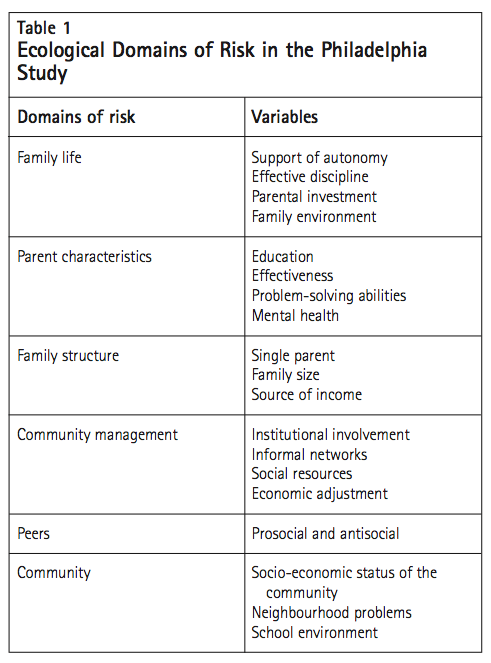
A more recent study, conducted in Philadelphia by Furstenberg et al. (1998), used a more refined methodology. Basing their work on a model developed by Bronfenbrenner (1977), the researchers included risk factors in six different ecological domains, notably the microsystem (the family, for example, in which the child is an active agent) and the systems that influence the child’s development but in a more indirect way (the community, for example). This adapted model is shown in table 1. It provides a conceptual departure point for my own model of risk factors (see figure 1 on p. 7).
Furstenberg et al. (1998) then measured five variables of psychosocial adaptation in adolescents: psychological adjustment, sense of competence, problem behaviour, participation in activities and academic performance. In examining the relationship between each variable and adolescent adaptation, the authors observed that some variables — for example, lack of support for autonomy, negative family environment, lack of social networks — represent a risk in relation to all aspects of development, while others — for example, low parent education or single-parent household — affect only some aspects of child development. Taking into account the cumulative effect of all these risk factors, they observed the same relationship as that discovered earlier by Rutter (1987) and Sameroff (1998): the adolescent’s degree of adaptation decreases significantly in relation to the number of risk factors he or she was exposed to earlier in life. This effect is particularly evident in the adolescent’s psychological adjustment and academic performance.
These findings show that exposure to four or more risk factors constitutes a critical threshold at which a child’s development is compromised. It is in this sense that I speak, in the following pages, of “vulnerable situations” and “vulnerable children.”
As with the concept of risk, a great deal is now known about child adaptation because of numerous research studies carried out in Quebec and elsewhere. These studies also show that children’s behaviours and cognitive abilities are good predictors of their later adaptation.
The results of longitudinal studies conducted in Quebec – the Longitudinal and Experimental Study of Low SES Boys in Montreal (ELEM) of 19842 and the Longitudinal Study of Kindergarten Children in Quebec (QLSKD) conducted in the late 1980s3 — found, for example, that children who demonstrate a high degree of physical aggressiveness in kindergarten are likely to manifest many other problems. These children show high levels of hyperactivity, inattention, and anxiety and a lack of prosocial behaviours. In addition, they are rejected by their peers and display mediocre school performance and disruptive behaviours in class (Haapasalo and Tremblay 1994; Tremblay et al. 1996; Vitaro et al. 1992). They are prone to being removed from their “natural” group of peers very early on and to ending up in classes, schools or specialized institutions where they meet other “deviant” children. All of these factors together constitute an ideal environment for the reinforcement of their marginal behaviour (Dishion, McCord, and Poulin 1999).
It has also been observed that, starting in preadolescence, these children are among the most delinquent: they are the first to start using alcohol and drugs and to engage in sexual relations, and they are at high risk of dropping out of high school, being involved in serious accidents, having a criminal record, being diagnosed with a psychiatric disorder and experiencing adaptation problems as adults (Dobkin et al. 1995; Fontaine et al. 2008; Nagin and Tremblay 1999; Tremblay et al. 1995).
The behaviours associated with these numerous adaptation difficulties may, however, be observed even before the child enters the school system (Tremblay et al. 1999; Tremblay et al. 2004). The foundations for school performance, health status, quality of life and workforce performance are laid in the first years of life.
Children’s socio-affective adaptation therefore plays an important role in ensuring that they get a good start in school. Cognitive skills, likewise, are important predictors of school performance. They are a significant element in the concept of school readiness (Janus and Offord 2000). In order to benefit fully from what schooling has to offer, children must possess good language skills, an ability to clearly communicate their needs and express their ideas, a knowledge of basic mathematical concepts, and a store of general knowledge (Doherty 2007a). Children who are well prepared for school have the basic skills that are essential to the development of more complex skills. Over time, they make significantly better progress than children who start school with lessdeveloped cognitive skills. Young children who do not get the stimulation that is crucial for cognitive development tend to have trouble overcoming these deficits later in life (Cleveland et al. 2006; McCain and Mustard 1999).
Vocabulary development is especially important for children’s school readiness. In fact vocabulary level is a good indicator of cognitive skills and has proved to be an excellent predictor of school success (Dunn, Thériault-Whalen, and Dunn 1993). The process of acquiring solid and varied reading skills, which is crucial to getting ahead both in school and in life, is a complex process that is facilitated by a good vocabulary. Moreover, a rich vocabulary helps children to recognize and decode the words they encounter upon starting school. These skills, in turn, prove useful later on during the more complex processes involved in acquiring reading skills such as text comprehension (Storch and Whitehurst 2002).
The results of six vast longitudinal studies undertaken in North America and Europe also highlight the importance of knowledge acquired at the start of one’s schooling – knowledge of numbers, letters, and words and their meaning, which is strongly associated with learning and with success during childhood and adolescence, right up to adulthood (Duncan et al. 2007). These results show clearly that “knowledge begets knowledge” and that children’s cognitive skills at school entry have a great impact on their educational trajectory. For an overview of these studies, see appendix 1.
The studies undertaken in Quebec and elsewhere converge in the sense that they trace a consistent profile of the risk factors likely to compromise children’s optimal development. These risk factors can be represented in an ecological model (Bronfenbrenner 1977; Garbarino 1990) in which the child develops and thrives through his or her interactions with the physical and human environment.
In this dynamic and interactive model, individual development is influenced by different systems containing a variety of eventual risks having a more or less direct impact. Because the child is at the centre of the model, a characteristic such as his or her health is a factor directly linked to skills development. To this must be added the family environment in which the child grows up. The quality of interactions with family members is immensely important. Parenting skills, as manifested by good parenting practices and the provision of a stimulating environment, have a direct impact on child development and are considered to be proximal protective factors.
Parenting skills are, however, associated with family characteristics that are removed from the child’s immediate experience but that call into play the context in which family interactions take place. Among the distal risk factors are the mother’s age at the child’s birth, the mother’s education and mental health, degree of family functioning, single-parent household and family socio-economic status.
Finally, the family system is part of a physical and social environment whose particular characteristics are likely to influence the well-being of the members of a community. This is why living in a neighbourhood that offers limited social support, safety and resources may represent an additional risk factor that, in conjunction with other potential risks, contributes to the development of adaptation difficulties in children.
It must nonetheless be pointed out that exposure to a single risk factor is insufficient to compromise individual development. It is the accumulation of risk factors and their additive contribution to the child’s developmental trajectory that may hinder development. Children who grow up in families characterized by a large number of negative influences are therefore at risk of not turning out as well as those exposed to few risk factors (Sameroff and Fiese 2000). The results of my analyses confirm this conclusion.
The QLSCD has, since 1998, conducted annual surveys on the development of 2,223 young children. The data collected have enabled researchers to draw a detailed portrait of the life context in which these children are growing up. Selected from the birth registry, the cohort is a representative sample of children born in Quebec between October 1, 1997, and July 31, 1998 (for more details, see Jetté and Des Groseilliers 2000).
The goal of the QLSCD, which began when the children were five months old, is to determine the risk and protective factors that, during a crucial period in the children’s development, might hinder or facilitate their adaptation to the school environment. The vast quantity of data collected has made it possible to: (1) establish a detailed profile of the sociodemographic and relational context in which the children are growing up; (2) examine the link between the risk factors present in the children’s lives and their social, emotional and cognitive development from birth to kindergarten entry; and (3) ascertain the links between the degree of risk the children are exposed to and their attendance at a child care service, which may subsequently represent a protective factor (Côté et al. 2007; Geoffroy et al. 2007).
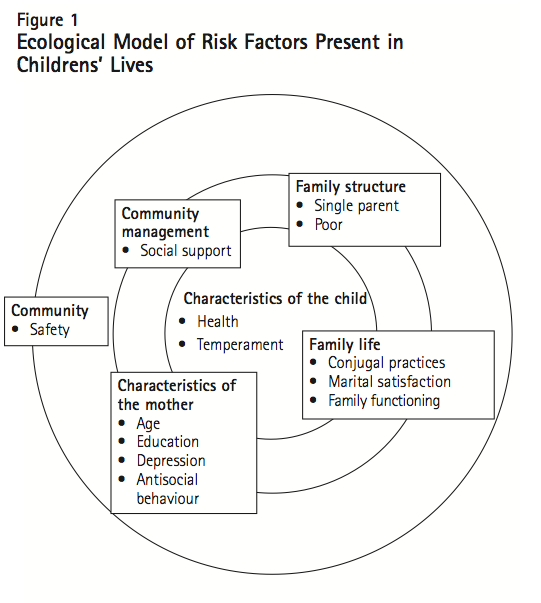
The data collected by the QLSCD therefore allow us to create a detailed profile of various risk factors that may influence the adaptation of children in Quebec. These risk factors, which were chosen in light of the studies cited above, may be regarded in an ecological perspective. Building on the work of Furstenberg et al. (1998), we established six ecological domains,4 the model for which is shown in figure 1. This model includes proximal factors such as the characteristics of the child as well as variables concerning the quality of interactions between the parents and the child and among family members. These factors are situated in a series of distal factors such as characteristics of the mother and the family and indicators related to neighbourhood quality.
Risk factors are generally presented in a dichotomous mode — that is, they are considered to be either present in or absent from a child’s life. In the case of categorical variables (such as the child’s health or the mother’s education), we therefore determined that a risk is present if, for example, the mother does not have a high-school diploma. For risk factors based on continuous variables (such as maternal depression, family interactions and neighbourhood characteristics), we looked to previous research (summarized in Puma et al. 2007; see also Sameroff 2006) in order to establish a risk threshold, which is situated at a specific point on the scale and includes the 25 percent of children found at the bottom (lowest quartile) or the top (highest quartile), as the case may be.5 This classification is presented in table 2. Table 3 shows at which of the six data collections the variables were collected throughout the study, from age five months to the year before kindergarten entry when the children were, on average, five years old. Table 3 also shows that, each year from age five months to the year before kindergarten entry, between 10 and 12 risk factors are potentially present in the child’s life. It should be noted that the characteristics of the child and the mother that were collated only at the start of the QLSCD were considered to be risk factors present at later collections, because their impact remained significant with respect to the adaptation indicators during childhood and adolescence (Furstenberg et al. 1998; Garmezy 1993; Sameroff et al. 1987).
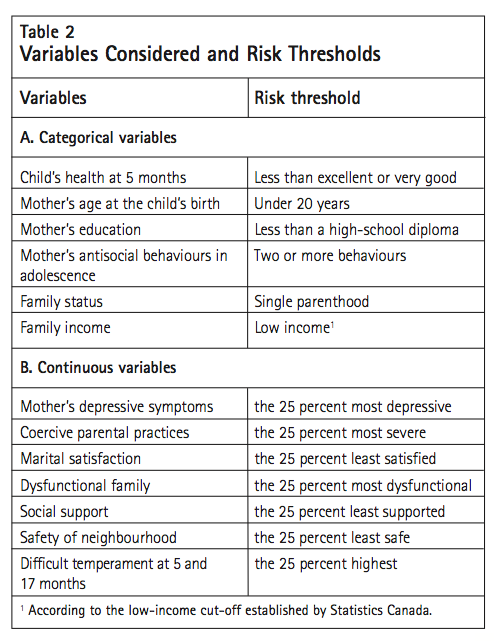

Starting at the second data collection, when the children were 17 months old, certain aspects of their behaviour were examined on an annual basis to gain a better understanding of the context in which some behavioural problems emerge. The measures were obtained from numerous sources by Richard E. Tremblay of the Research Unit on Children’s Psychosocial Maladjustment at the Université de Montréal and the scientific director of the QLSCD, in consultation with D. Offord and M. Boyle of Chedoke-McMaster Hospital.6
The data related to child behaviour were collected from the person most knowledgeable about the child (PMK). In 99.7 percent of cases, the PMK is the biological mother. This person indicates the frequency at which the child exhibits a series of behaviours (never, sometimes or often). These may be grouped in dimensions such as hyperactivity, emotional problems, anxiety, indirect aggressiveness, physical aggressiveness, opposition, inattention and prosocial behaviours.
Subsequent to preliminary analysis, we retained the measures that had a significant correlation with the above risk factors, namely those with links to the behaviours of physical aggressiveness, hyperactivity, inattention, opposition and anxiety.7
To measure the children’s learning capacity, a vocabulary test was administered when they reached prekindergarten age (about four and a half years). The following year, when they were in kindergarten and about five and a half, the test was administered again.
The French version of the Peabody Picture Vocabulary Test — Revised (PPVT-R) by Dunn and Dunn (1981), adapted for a francophone population and validated by Dunn, Thériault-Whalen, and Dunn (1993), was used to measure the children’s word comprehension. The Vocabulary scale of the Peabody Picture Vocabulary Test (PPVT) is individually administered and takes 10 to 20 minutes to complete, depending on the child’s age. The results obtained with the PPVT are closely correlated with the IQ obtained using other scales (Dunn and Dunn 1997). Although the PPVT targets only the competencies related to receptive vocabulary — that is, comprehension of words measured through the identification of their corresponding images — the results make it possible to accurately predict later school success (Williams and Wang 1997). Each child receiving the Vocabulary scale of the PPVT was given a raw score8 based on a calculation of the correct answers from a maximum of 170 images to be identified. The mean scores obtained at prekindergarten and kindergarten age were, respectively, 67.1 (standard deviation = 18.92; N = 967) and 80.47 (SD = 17.12; N = 1,161).
To obtain a profile of the children from the perspective of their knowledge of numbers and basic mathematical concepts, another test was administered when they were prekindergarten age and also the following year, when they were in kindergarten. The Number Knowledge Test (NKT; Okamoto and Case 1996) was developed by Robbie Case of the University of Toronto. It is individually administered and serves as a means of measuring the child’s informal knowledge of the conceptual prerequisites for mathematical operations. Like language skills, numeracy skills are a good predictor of subsequent learning9 (Duncan et al. 2007). The highest possible score is 18. The mean scores for all participants at prekindergarten and kindergarten age were, respectively, 9.63 (SD = 4.1; N = 985) and 13.3 (SD = 3.27; N = 1,186).
The results are presented in three steps. First, I consider the number of at-risk children — that is, those who were exposed to at least one risk factor at least once during early childhood. Next, I report on the prevalence of risks. In other words, I examine the children, from both a transversal and a longitudinal perspective, based on the number of risks they were exposed to during childhood. Finally, I examine the link between the risk factors and the adaptation indicators.10 The goal is to answer four questions: Is there a relationship between the number of risk factors present in the children’s lives and the adaptation indicators measured concomitantly?11 Does the number of risk factors that children are exposed to early in their lives make it possible to predict their level of adaptation? Is there a link between the number of years during which children are in an at-risk situation in early childhood and the adaptation indicators measured at prekindergarten and kindergarten age? Finally, is there a link between the number of risk factors present in children’s lives and their attendance at a child care service?
Table 4 shows the percentages of children considered to be at risk according to my classification. Recall that I established a risk threshold (the 25 percent lowest or highest) for the risk factors that are based on continuous variables such as maternal depression, interaction among family members and neighbourhood characteristics (see table 2). Therefore, table 4 presents only the percentages for the categorical variables.
Table 4 shows that the children’s health at age five months is less than very good in 7 percent of cases. Almost 10 percent of the children were born to a mother under 20 years of age. Almost one child in 20 was born to a mother who did not graduate from high school; this proportion drops during subsequent data collections, which may be attributable to the fact that some mothers returned to school to complete their secondary studies (Japel et al. in press) or to the selective attrition of the most disadvantaged families — a problem commonly encountered in longitudinal studies12 (Human Resources and Social Development Canada 2002).
In addition, almost one child in 20 was born to a mother who demonstrated more than two antisocial behaviours during adolescence. As for the percentage of children living in a single-parent family, there is a significant increase over time: when the children are five months old, 8 percent are living in a single-parent family; but when the children reach the age of five years, this percentage almost doubles (to 15 percent). It is worth noting that the number of lowincome families seems to decrease over time: 23 percent of children are living in low-income families at age five months, while the rate is 17 percent prior to kindergarten entry. As in the case of mother’s education, this decrease is most likely attributable to the loss of some survey participants rather than to the general improvement in families’ economic situation.
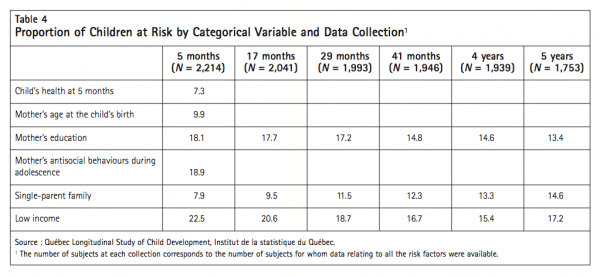
Figure 2 illustrates the distribution of children according to the number of risk factors present in their lives at each data collection before kindergarten entry. It reveals that the distribution does not change a great deal from one data collection to the next: Each year, about one child in six in this cohort grows up in a totally risk-free environment. A little over one child in five is exposed to one or two risk factors during early childhood, and about one child in six lives with three risk factors during at least one of these years. One child in 10 is exposed to four risk factors and just over one child in 20 lives with five risk factors at some point during early childhood. The incidence drops gradually as the number of risk factors increases.
Figure 3 presents the percentage of children surveyed by the QLSCD who are “vulnerable” based on the index of cumulative risk — that is, the children who live with four or more risk factors. It shows that the percentage of such children is relatively stable from age five months to five years, and that almost one quarter of them are exposed, during at least one period in early childhood, to unfavourable living situations that are likely to hinder their development.
While it is important to identify the group of children who are vulnerable each year, it is equally so to determine whether this vulnerability status remains from one year to the next, so that a longitudinal index of cumulative risk can be drawn up.
Figure 4 shows the breakdown of the number of children by the number of times they are in a vulnerable situation — that is, in a life context where four or more risk factors are present — over all six years of the data collection. It appears that more than half of the children surveyed in the QLSCD (59 percent) were never exposed to such a situation during their preschool years. About 12 percent experienced such conditions once during this period, 7 percent twice, 5 percent three or four times, and 4 percent five out of the six years before starting kindergarten. Finally, 8 percent of children experienced unfavourable conditions throughout their lives — that is, from five months to five years.
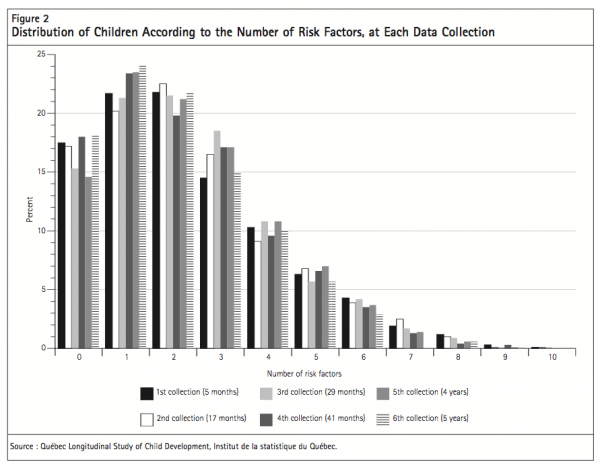
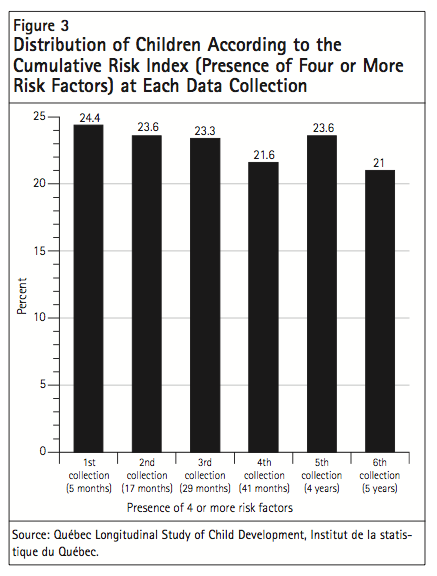
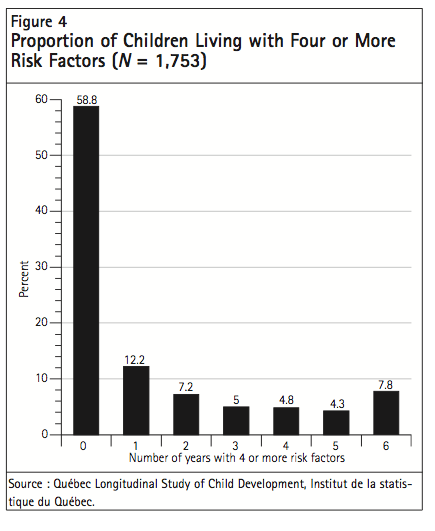
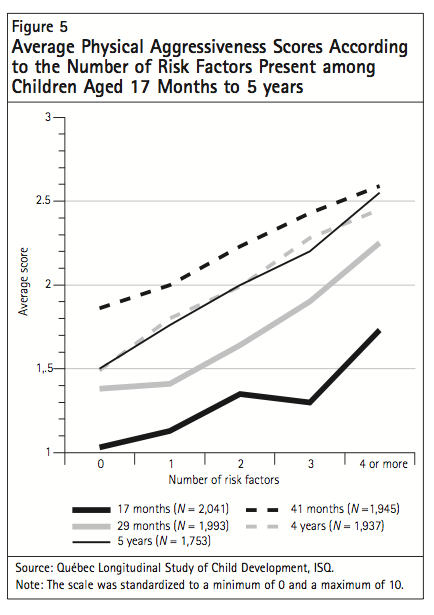
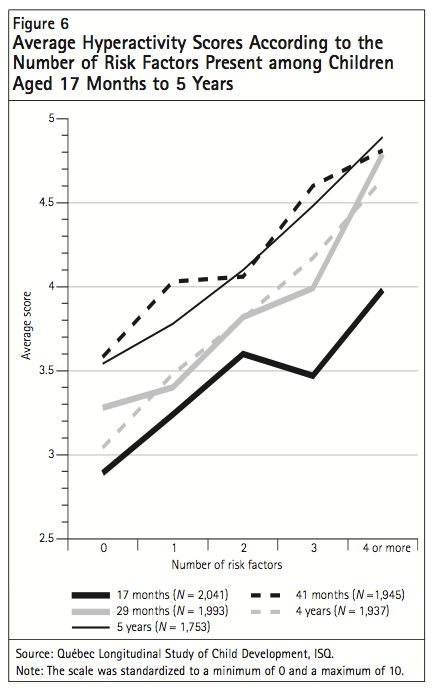
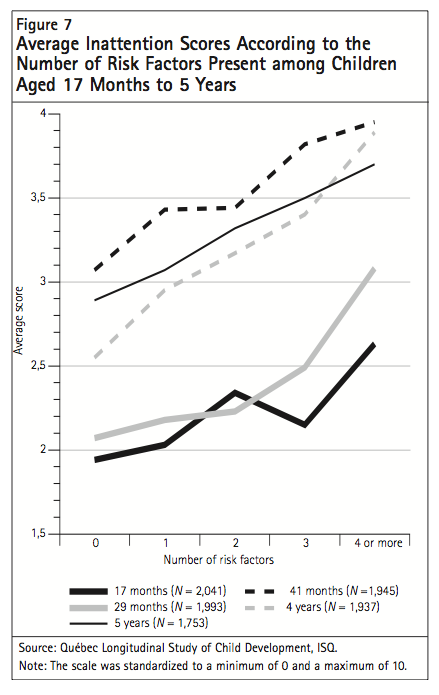
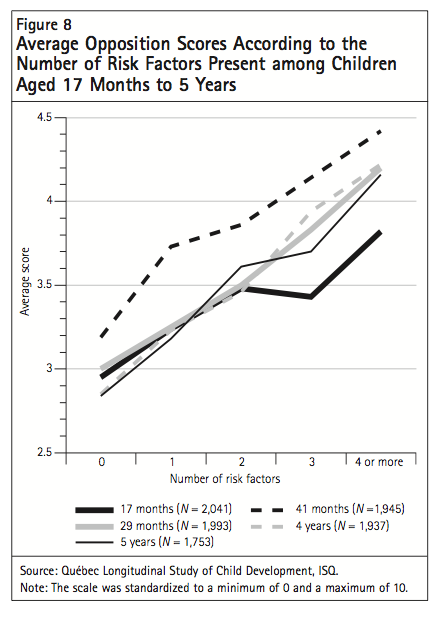
Within the framework of the QLSCD, the person most knowledgeable about the child (PMK) annually provides information on the child’s behaviour, starting at age 17 months. Figures 5 to 9 illustrate the link between the number of risk factors and the mean scores on the behaviour scales, based on the information provided by the PMK. Figures 10 and 11 illustrate this link for the predictors of cognitive development evaluated at prekindergarten and kindergarten age.
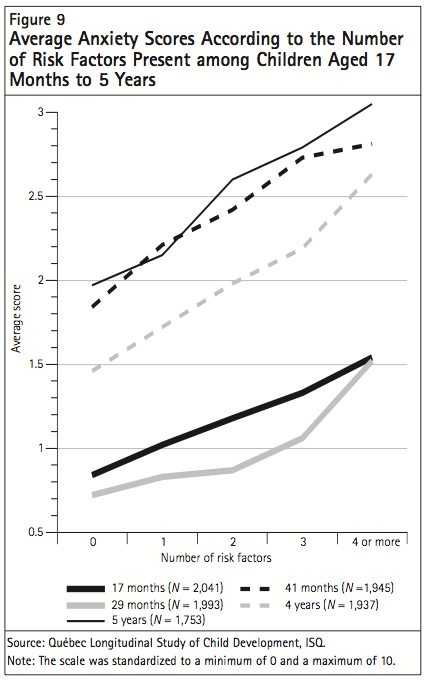
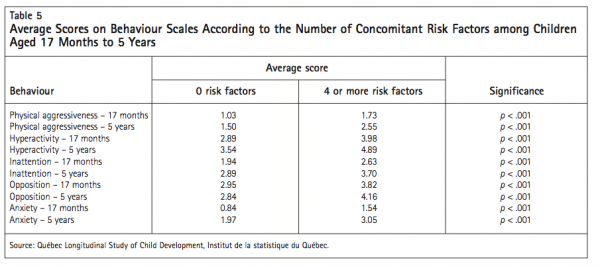
At first glance, these figures indicate steep gradients in conjunction with the rising number of risk factors present in the child’s life. These gradients are observed at every data collection.
As might be expected, at every data collection vulnerable children (exposed to four or more risk factors) generally display higher levels of physical aggressiveness, hyperactivity, inattention, opposition and anxiety than children exposed to no risk factors. Table 5 shows the means of these two groups of children at the first data collection, at age 17 months, and at the last, at prekindergarten age. Significant gaps are evident between the two groups at these two points. These differences are also significant at p < .001 for the other data collections (the results of which are not shown, to lighten the table).
Figures 5 to 9 and table 5 also reveal that, even for the no-risk children, the initial mean scores increase with each data collection: The frequency of physical aggressiveness, hyperactivity, inattention and anxiety increase with the age of the child. This is likely because certain behaviours are less frequent or more difficult to detect at a very young age. However, this increase is not seen for oppositional behaviours, perhaps because these behaviours are prevalent at around two or three years of age and tend not to increase greatly after that.
Figure 10 shows the link between the mean scores for the vocabulary test (PPVT), administered when the children are at prekindergarten age (about five years) and kindergarten age (about six years), and the risk factors present in their lives at age five. There is a clear gradient indicating an unambiguous relationship between the number of risk factors and children’s performance with respect to vocabulary comprehension.
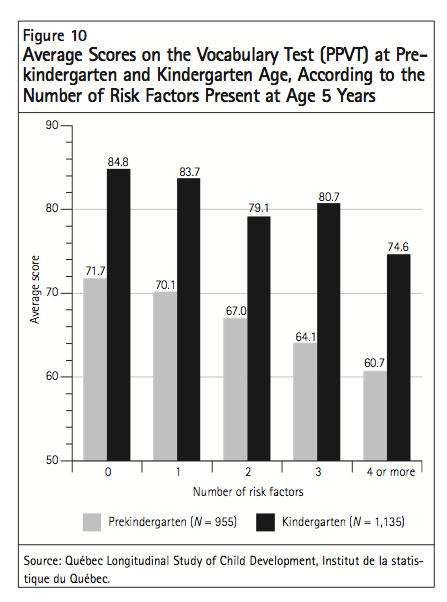
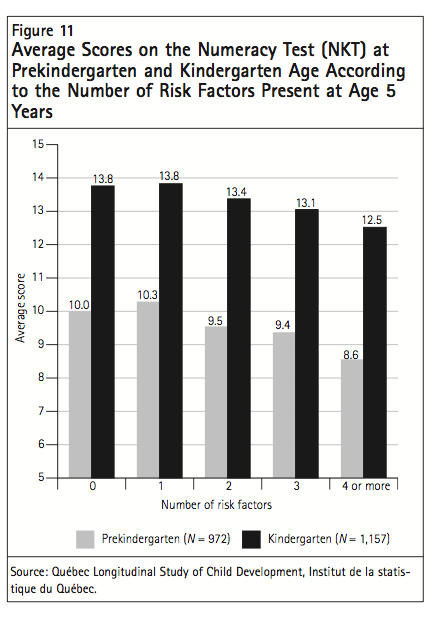
Consequently, in both prekindergarten and kindergarten, the children who, at age five, experience a life context where they are exposed to four or more risk factors do not perform as well as the no-risk children. Indeed, the children who are most at risk demonstrate, at these two times, a score that is, on average, 10 points lower than that for the no-risk children (p < .001).
Figure 11 illustrates the link between the number of risk factors present at about five years of age and the child’s performance on the numeracy test administered in prekindergarten and kindergarten. It reveals a gradient indicating that performance on this test declines in relation to the number of risk factors to which the child is exposed. Children living in a high-risk environment therefore perform less well than those exposed to no risks (p < .01).
In this section I have attempted to determine the predictive power of risk factors present at the start of life in relation to adaptation indicators measured from the age of 17 months until when the children are in kindergarten and are, on average, six years old. Figures 12 to 18 make a link between the risk factors observed at five months and the various behaviours measured starting at 17 months, as well as the cognitive tests administered in prekindergarten and kindergarten.
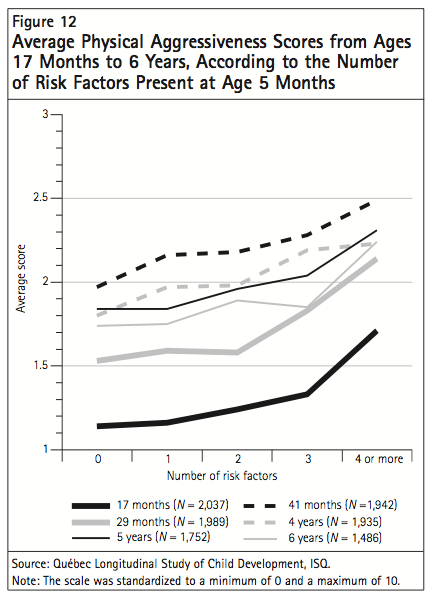

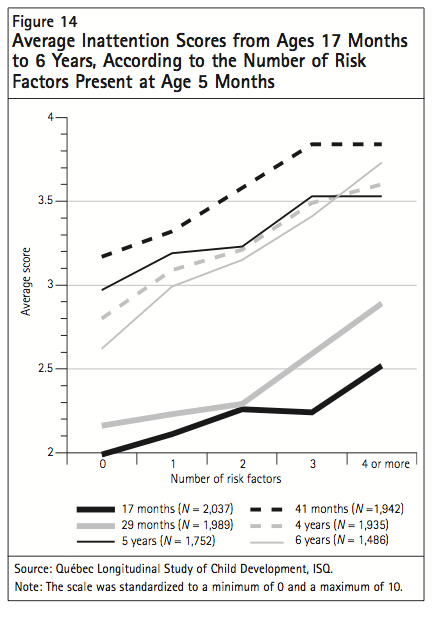

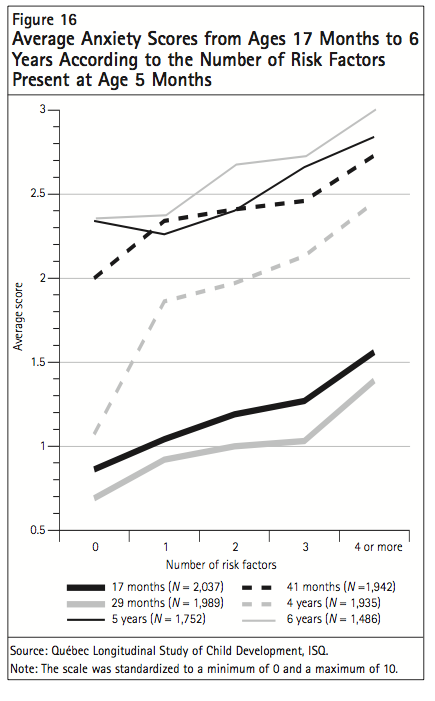
Figures 12 to 16 show very clearly the increase, in relation to the number of risk factors present at the age of five months, of the mean score on the scales of physical aggressiveness, hyperactivity, inattention, opposition and anxiety. The frequency of these behaviours increases gradually with the number of risk factors. As we saw earlier in examining the links with the concomitant risk factors, the group of children most at risk show higher levels of physical aggressiveness, hyperactivity, inattention, opposition and anxiety than the children who were not exposed to risk factors at the age of five months.
The mean scores on the behaviour scales at the start of data collection and when the children were in kindergarten are presented in table 6. These means are similar to those presented in table 5, which examines the links with the concomitant risk factors. These results suggest that the risk factors present in the first year of life are almost as valuable as the concomitant characteristics of the life context in terms of assessing behavioural adaptation during the preschool years.
Figure 17 shows the link between the number of risk factors present at five months and the children’s performance on the test measuring receptive vocabulary, administered at five and six years of age. Observe that in prekindergarten and kindergarten the mean score decreases in relation to the number of factors identified at the start of the children’s lives. Indeed, at these two ages, the children who began life exposed to four or more risk factors perform less well than those exposed to either a single risk factor or none at all at the start of their lives (p < .001).
Is there a link between the risk factors present in early childhood and children’s performance on a numeracy test administered when they reach prekindergarten and kindergarten age? Figure 18 reveals that these scores decrease in relation to the number of risk factors present in early childhood. At five years of age, children not exposed to a risk factor during their first year of life do better on this test than those exposed to multiple risk factors (p < .05). This gap remains at kindergarten age (p < .001).
The figures discussed above show that cognitive performance decreases and problem behaviours increase in relation to the number of risk factors present in children’s lives. I also examined the provenance of children in kindergarten in the highest quartile (25 percent) on the physical aggressiveness scale and the lowest quartile of performance on the vocabulary and numeracy tests. As can be seen in figure 19, the children who were exposed to multiple risks in their first year of life are about twice as likely to appear in the lowest quartile with respect to performance on the tests for vocabulary (PPVT) and numeracy (NKT), and are also overrepresented among those who display a high level of physical aggressiveness.
Finally, I carried out multiple regression analyses to identify the risk factors present at the age of five months with the best potential to predict the scores obtained later on the PPVT and NKT and the physical aggressiveness scale in kindergarten. I integrated in these regressions all the risk factors considered in this paper in order to determine the factors that best explain the variance in these three indicators.
Table 7 presents the results of these regressions. Note that the levels of income adequacy, family functioning, child’s health at five months and mother’s education are the best predictors of performance on receptive vocabulary in kindergarten. The level of income adequacy, child’s health at five months and mother’s education are also the best predictors for numeracy. Finally, the most powerful risk factors for the level of physical aggressiveness in kindergarten are the child’s health at five months, mother’s education, mother’s depressive symptoms and mother’s antisocial behaviours during adolescence.
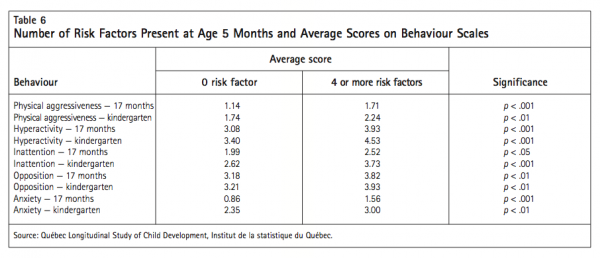
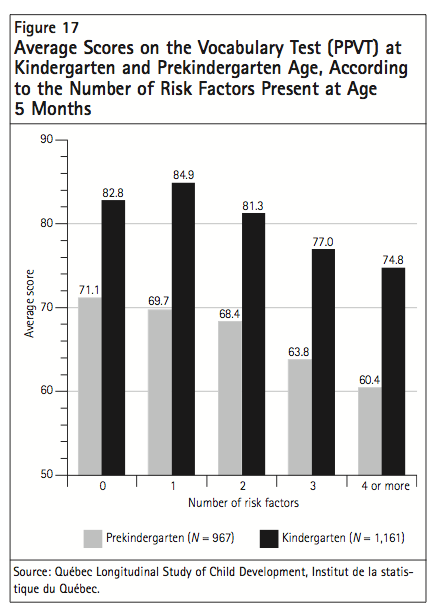
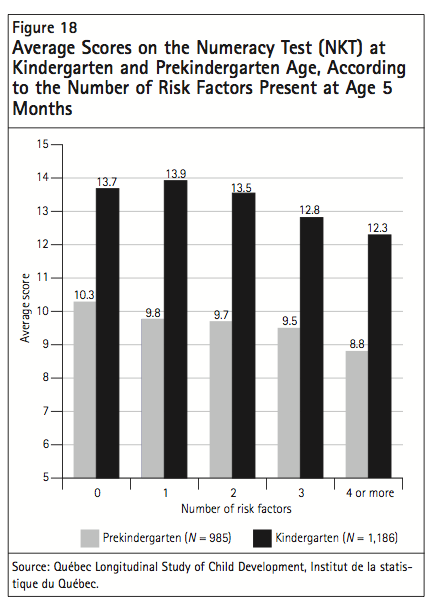
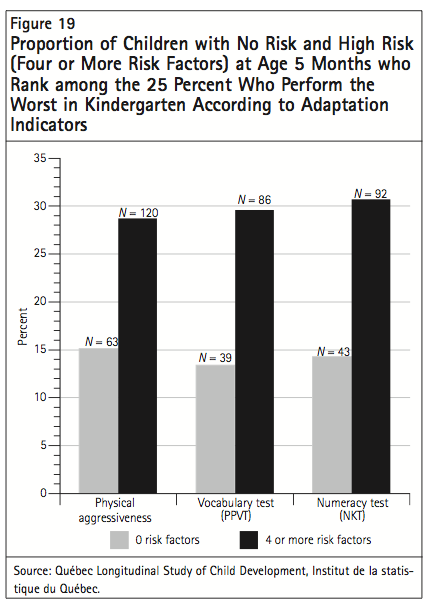
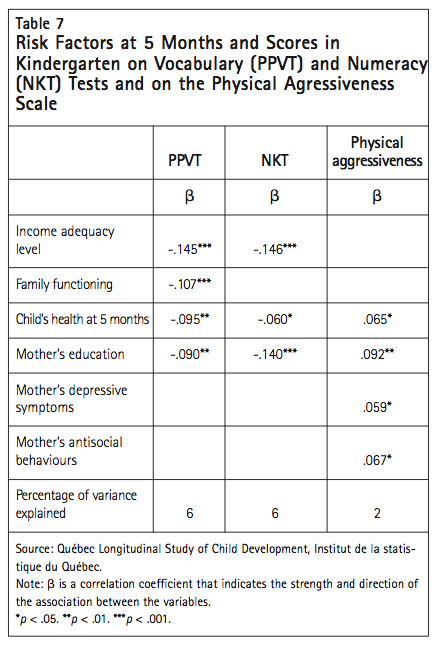
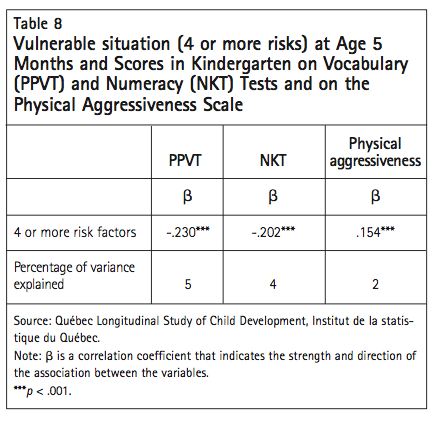
Are the risk factors presented in table 7 better predictors of the scores observed for the adaptation indicators than other combinations of risk factors at the age of five months? Given the large variety of combinations of risk factors and the impossibility of identifying significant subgroups to determine whether certain combinations of risk factors have a greater impact than others on the adaptation indicators, I carried out further multiple regression analyses, taking into consideration the accumulation of risk factors. As shown in table 8, no matter what the combination of factors, exposure to multiple risk factors at a young age makes it possible to predict, with reasonable accuracy, the scores on the physical aggressiveness scale and the cognitive performance tests. Independent of the type of risk factors present in the child’s life, then, it is the accumulation of factors that affects his or her adaptation.
In order to determine the impact of exposure to “repeated” vulnerable situations (four or more risk factors) on children’s psychosocial adaptation and cognitive development at prekindergarten and kindergarten age, when they are, on average, five and six years old, I examined the link between these indicators and the number of years they lived in a vulnerable situation during their preschool years. The link between the number of years spent in a vulnerable situation and the behaviours of physical aggressiveness, hyperactivity, inattention, opposition and anxiety is illustrated in figures 20 to 24.
These figures show that, for all these behaviours, the mean score increases in relation to the number of years the child lives in a vulnerable situation. This increase becomes significant starting with four periods of vulnerability for the majority of the measured behaviours. Consequently, when they reach prekindergarten and kindergarten, children who lived in a vulnerable situation for four, five or six periods during their preschool years demonstrate higher levels of physical aggressiveness, hyperactivity and opposition than those who never lived in a vulnerable situation.
With respect to the behaviours of inattention and anxiety, the relationship between the number of years in a vulnerable situation and the mean scores for the behaviours does not seem as linear. With inattentive behaviours at prekindergarten age, only one significant difference is seen, that between children who never lived in a multiple-risk environment and those who did so for four years. At the age of six years, this difference is seen in the children who lived four or five periods in an environment where four or more risk factors were present (see figure 22). In the case of anxious behaviours, at the age of five only two differences are discernible: Children who lived for four or six years in an environment with four or more risk factors demonstrate more anxious behaviours than those never exposed to such a context. At kindergarten, this difference is seen in the children who lived two, four or six years in a multiple-risk context.
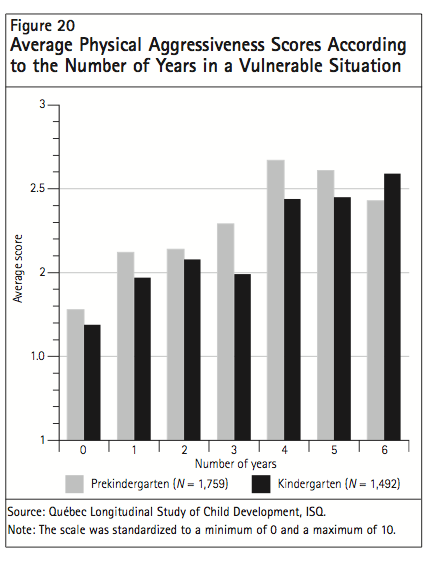
The mean score on the receptive vocabulary test (PPVT) administered at the ages of five and six years and its association with the number of years that a child spends in a vulnerable situation before starting kindergarten are presented in figure 25. Note that the relationship between these two factors is not entirely linear. Nonetheless, at five years of age children exposed to multiple risk factors for two, four, five or six years have less developed language skills than children never exposed to this degree of risk. At kindergarten age, having spent five or six years in a vulnerable context is associated with a wide gap in relation to children who never experienced this life context. This gap amounts to more than 10 points at both five and six years of age.16
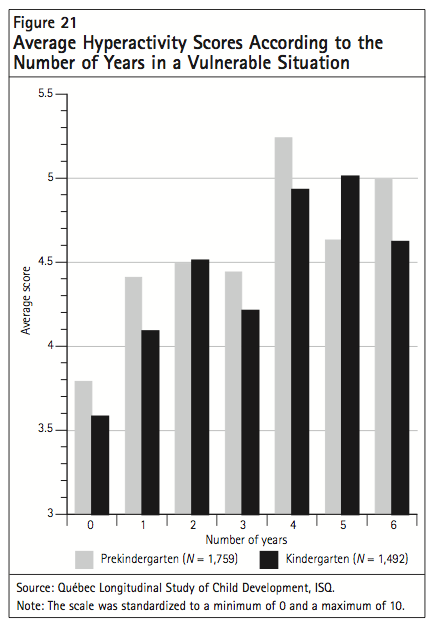
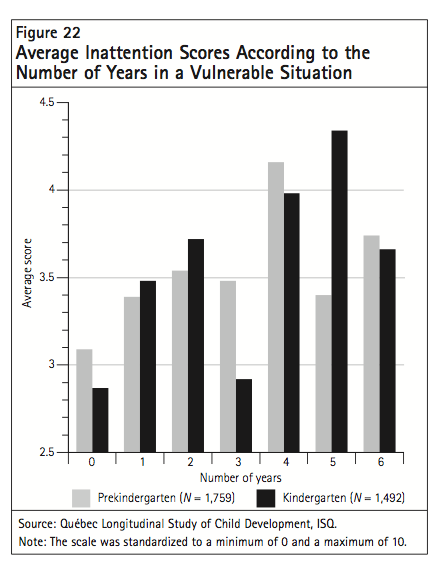
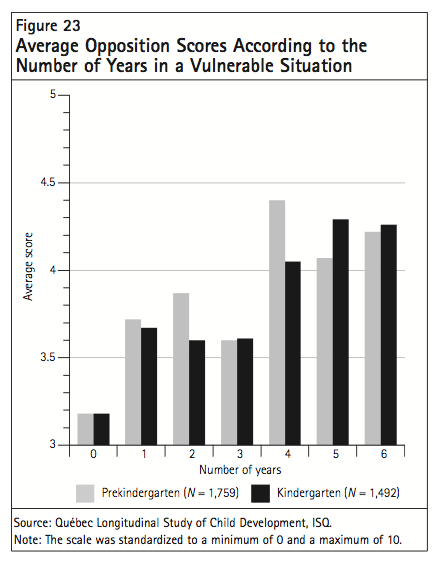
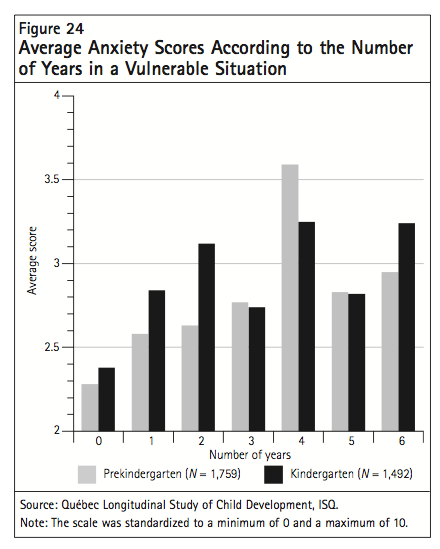
Figure 26 shows the link between the mean score on the numeracy test and the number of years the child lived in a multiple-risk environment. At prekindergarten and kindergarten age, the scores gradually drop as the number of years spent in a vulnerable situation rises. Only at the extremes are significant differences found. Therefore, at about five and six years of age, only those children who lived their entire life (six periods) in a multiple-risk environment have a significantly lower score on this test than children never exposed to such conditions. Moreover, at kindergarten age, this gap is also seen in children who spent five years in a multiple-risk environment. Note that this gap amounts to about 2 points.17

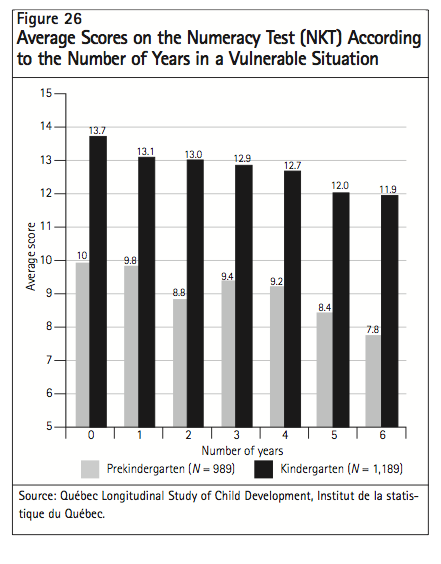
At each data collection, the parents indicated whether their child attended some type of child care on a regular basis. Figure 27 shows the results, according to the age of the child and the number of risk factors in their environment.19 A significant gap is seen in the percentages of no-risk and high-risk children with respect to attendance at a child care service: the number who attended child care during their preschool years is lower for those living with multiple risk factors.
Figure 28 presents the average duration in years of attendance at a child care service from the age of five months to five years, compared to the number of years during which the children lived in a vulnerable situation. A clear drop is seen in the average time spent at a child care service in relation to the number of years lived in a vulnerable situation. The children who never experienced a multiple-risk environment attended a child care service for almost four years, on average, before starting kindergarten. This is significantly longer than for the children who experienced two, five or six periods of vulnerability — 3.2, 2.7 and 2.6 years, respectively.
The analyses presented in the previous section point to a relationship between the number of years spent in a vulnerable situation and a high level of physical aggressiveness as well as poorer cognitive performance. To determine whether attendance at a child care service during the preschool years might reduce the impact of these living conditions and also act as a protective factor, I carried out multiple regression analyses taking into account the number of years spent in a vulnerable situation and attendance at a child care service. This type of analysis provides a means to detect the impact of one variable (attendance at a child care service) by controlling for the effect of another (number of years in a vulnerable situation).
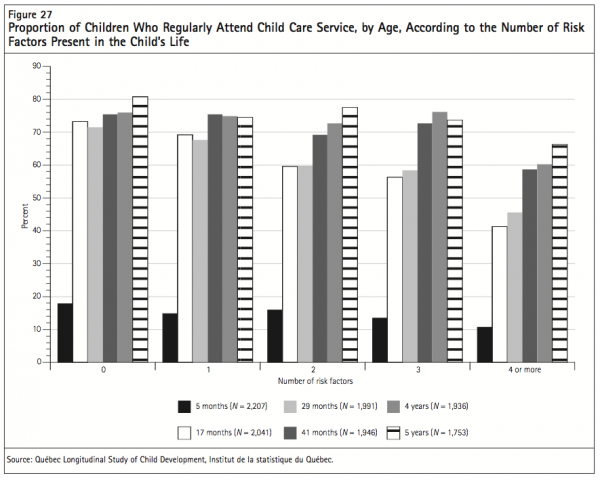
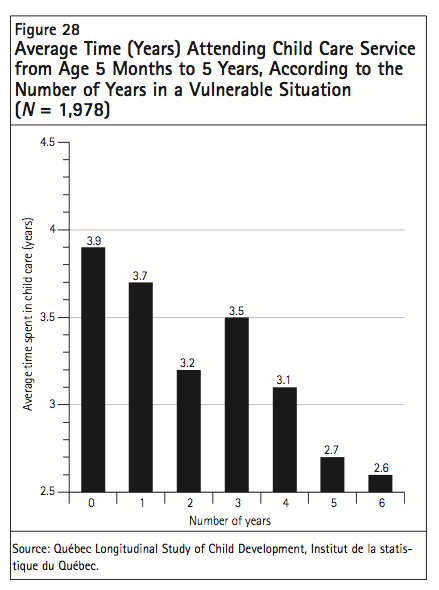
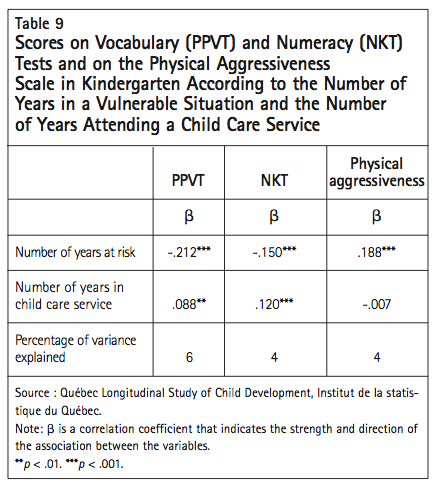
As seen in table 9, there is a significant drop in performance on the tests measuring vocabulary and pre-math concepts and a dramatic rise in physical aggresiveness in relation to the number of years lived in a vulnerable situation. But the number of years attending a child care service also has a significant impact on performance on the cognitive tests administered in kindergarten.
Independent of the duration of a vulnerable situation, children’s performance on the cognitive tests increases in relation to the number of years they attend child care. The duration of attendance at a child care service has an impact on the development of the cognitive skills of all the children. However, these positive outcomes are not found for level of physical aggressiveness.
The QLSCD shows that, at each data collection from five months to five years of age, almost one quarter of the children surveyed live in an environment in which they are exposed to four or more risk factors. At some point during their preschool years, these children have to deal with at least four developmental challenges that are, from an ecological perspective, proximal in character. These children may therefore be considered vulnerable.
Is it always the same children who find themselves in a vulnerable situation at each data collection? From a longitudinal perspective, the majority of children are never exposed to this degree of risk. More than one child in five nonetheless experiences a disadvantaged living situation for at least three years before reaching the age of six. In other words, a large number of young children have to cope with such a situation.
Risk factors, because of their cumulative effect, have the potential to compromise children’s social, emotional and cognitive development (Garmezy 1993; Sameroff et al. 1987). I therefore examined the impact of risk factors on the adaptation indicators in three different ways. First, I sought to establish whether the number of risk factors identified at each data collection is linked to variations in the indicators of psychosocial and cognitive adaptation measured concomitantly. Second, I examined the predictive power of the number of risk factors present during the children’s first year of life in relation to adaptation indicators measured from 17 months to kindergarten age. Finally, I looked at the link between the frequency of the vulnerable situation before the age of six and its impact on child adaptation at prekindergarten and kindergarten age.
With respect to the concomitant relationship between the number of risk factors and the children’s adaptation, the analysis made it possible to determine any significant links between the two elements. In the case of the five indicators of behavioural adjustment, for example, there is a steep gradient as the number of risk factors rises, indicating a close link between the characteristics of the children’s life context and their psychosocial adaptation. This link also exists for cognitive performance, which decreases significantly in relation to the number of risk factors in the child’s life.
With respect to the living situations of children in their first year of life, we have shown that they are strong predictors of their adaptation right up until school entry. Indeed, the gradients for the different behaviours and cognitive skills reveal a definite increase in the behaviours of physical aggressiveness, hyperactivity, inattention, opposition and anxiety as well as a sharp decrease in performance on cognitive tests in relation to the number of risk factors observed at the age of five months. Moreover, the link with the adaptation indicators is very similar to the one observed for the concomitant conditions in the children’s life context. The presence of multiple risk factors at a very young age therefore makes it possible to predict with reasonable accuracy these children’s later adaptation. In addition, even though certain factors, such as family income, mother’s education and child’s health at five months, have particular weight with respect to later adaptation, my findings confirm the conclusion of earlier studies that it is the number rather than the quality of risk factors that is associated with the child’s behavioural and cognitive trajectory (Furstenberg et al. 1998; Sameroff and Fiese 2000).
The child’s adaptation at prekindergarten and kindergarten age is an important precursor of a successful school experience (Duncan et al. 2007; Tremblay et al. 1996). The child’s living situation at birth and the concomitant life context are strongly associated with his or her developmental trajectory. Even more important, however, is the duration of the vulnerable situation. As my results show, problem behaviours, notably physical aggressiveness, hyperactivity and opposition, are observed especially frequently in children who spend most of their preschool years in a vulnerable situation.
It should be noted that the type of scale used to measure these behaviours does not allow one to draw a psychiatric diagnosis: these scales were conceived to render a profile of a given population and variations within it. In general, however, the score obtained by vulnerable children on the behaviour scales is higher by about 20 to 70 percent, depending on their age and the indicator observed, than that of children who grew up with few or no risk factors. In addition, vulnerable children are clearly overrepresented in the highest quartile on the physical aggressiveness scale: they are almost twice as likely as no-risk children to find themselves in this problemprone zone.
These children’s futures are also at risk with respect to their cognitive abilities: their language and pre-math skills are much weaker than those of children who experience shorter periods of vulnerability or are never exposed to risk factors. Two recent studies conducted using the QLSCD data documented the nature of the relationship between the low level of school readiness of children in school and such factors as socio-economic environment and mother’s education (Desrosiers and Ducharme 2006; Lemelin and Boivin 2006). My results make it possible to go beyond identifying risk factors and to show that the accumulation of factors plays a key role in children’s performance. Children who grow up in a multiple-risk environment, whatever the nature of the risk factors, may be considered to display a relative delay in terms of cognitive development. My results reveal that, compared to children exposed to no risk factors, these children are overrepresented more than twofold in the 25 percent of children at the bottom of the scales measuring vocabulary skills and numeracy.
Several research studies have found that, for atrisk children, attendance at a high-quality child care service constitutes a protective factor with regard to school readiness (Côté et al. 2007; Geoffroy et al. 2007; Vandell 2004). Unfortunately, a smaller proportion of the multiple-risk children surveyed by the QLSCD benefit from this protective factor before entering the school system. Indeed, children who are vulnerable during several periods in their preschool years are generally less likely to attend a child care service. For them, however, and for all the children, it is the duration of those periods — the number of years attending a child care service — that is positively linked to their cognitive performance. Consistent with the reports of other researchers, I observed that all children, especially those from disadvantaged backgrounds, benefit from prolonged attendance at a child care service, at least with respect to their cognitive and language development (NICHD Early Child Care Research Network 2002).
This study draws a portrait of the living situations of a cohort of children born in Quebec in the late 20th century and describes the links between the children’s life context and their preschool psychosocial and cognitive development. The data show that a significant proportion of these children are growing up in suboptimal circumstances that can compromise their school success due to cognitive deficits and problem behaviours that may manifest early in their schooling.
The repercussions of a child’s personal and social characteristics for his or her school performance are well documented (Duncan et al. 2007; Lapointe and Japel 2007). Each of these characteristics has a strong influence on the child’s adaptation. Poverty, for example, is linked to numerous negative consequences in children (Duncan and Brooks-Gunn 1997; Pagani et al. 1999; Pagani 2007), as is living in a single-parent family (Sigle-Rushton and McLanahan 2004) or being raised by parents who have little education (Davis-Kean 2005) or who engage in poor parenting practices (Gershoff 2002). But the cumulative effect of these factors is even more powerful. Conceptualizing the child’s development from this perspective allows us to situate it in a broad ecological framework that considers the complexity and multiple influences of human development (Sameroff and Fiese 2000).
The risk factors are not, however, randomly distributed. Although they exist at every socio-economic level, they are concentrated in disadvantaged families (Sameroff 1998). Indeed, if we break down the QLSCD sample by income,20 only 12 percent of children from families with income above the low-income cut-off are vulnerable — that is, exposed to four or more risk factors — compared to 45 percent of children from lowincome families (data not shown).
This reality has significant repercussions with respect to interventions to improve the lives of vulnerable children. It should be noted, however, that even though a larger proportion of vulnerable children come from disadvantaged backgrounds than from more favourable socioeconomic backgrounds, a considerable number of children in the latter segment are also at risk of having their educational trajectory compromised by behavioural problems or cognitive delays. In my sample, in fact, the number of vulnerable children in families with an adequate income (above the low-income cut-off) (206 families) is almost as high as the number in low-income families (230 families).
Therefore, a strategy comprising only programs aimed at the disadvantaged segment of the population would cover a limited number of children in difficulty. We need targeted programs that are part of a universal approach — that is, a strategy that responds to the needs of children from more advantaged socio-economic backgrounds while investing more heavily in those who demonstrate the greatest need (Brownell et al., 2006; Doherty 2007b).
In a context characterized by multiple risks, however, an intervention that targets a single risk factor might not be sufficient to bring about significant changes (Sameroff and Fiese 2000). In the United States, for example, the program Moving to Opportunity, which was intended to improve children’s school success by giving parents the option of leaving their disadvantaged neighbourhood, did not produce the anticipated results (Leventhal, Fauth, and BrooksGunn 2005). The many dynamics that characterize a high-risk environment must be taken into account, since targeting one risk factor in isolation appears to hold little promise as an effective intervention.
According to the most recent report by the group Campaign 2000 (2006), about one Quebec child in six lives in a low-income family and is growing up in poverty. To address this reality, the province launched its Government Action Plan to Combat Poverty and Social Exclusion, whose proposed measures are to be implemented over five years (Ministère de l’Emploi, de la Solidarité sociale et de la Famille 2004). These measures include an increase in the minimum wage, annual adjustments to employment-assistance benefits, an increase in the number of affordable housing units, the setting up of food banks in local communities and disadvantaged neighbourhoods, and the development of multi-partner agreements aimed at increasing access to high-quality educational care for disadvantaged children.
To reduce the number of children exposed to the various consequences of poverty, multi-pronged strategies are thus needed. Such strategies are part and parcel of public policies that play a decisive role in creating a social context that promotes the optimal development of all persons. But poverty is also linked to individual factors, in particular parental education. A close correlation has been observed between not having a high-school diploma and a high rate of unemployment, increased difficulty finding work and, if the parent does work, an appreciably lower income (Caspi et al. 1998; Statistics Canada 2005). Parents with a low level of education are also more likely to demonstrate poor lifestyle habits and poor physical and psychological health, as well as to create socioeconomic situations that might eventually compromise their children’s development (Holyfield 2002; Japel, Tremblay, and McDuff 2000; Ross 2005). The mother’s education seems to play a particularly important role in children’s psychosocial adaptation and cognitive development (Davis-Kean and Magnuson 2006; Tremblay et al. 2004). Moreover, when the mother improves her level of education, significant cognitive benefits are observed in the child; these positive effects are especially pronounced in children whose mothers had previously failed to complete high school (Japel et al. in press).
A low level of education is not only linked to poverty but also appears to coincide with other risk factors – for example, the mother’s age at birth of her first child; single-parent household; previous adaptation problems and poor mental, physical and psychological health; and poor parenting practices (Japel, Tremblay, and McDuff 2000; Zoccolillo 2000). Considering the numerous, cumulative risk factors and their well-documented impact on the next generation, intervention with this group of parents is extremely important.
Several programs have targeted this high-risk group and report positive outcomes for both mothers and children (Tremblay and Japel 2003). One exemplary program that is often cited and emulated is the American Nurse Home Visitation Program, founded by David Olds (Olds et al., 1997, 1999, 2002). This program, which includes multi-form interventions starting even before the birth of the child, is a cornerstone of the program Integrated Perinatal and Early Childhood Services for Families Living in Vulnerable Situations, which has been operating in Quebec since 2004 (Ministère de la Santé et des Services sociaux 2004). It is based on an ecological approach aimed at establishing interventions and partnerships that make it possible to take action on behalf of families and communities, as well as the environment in which they live.
It goes without saying that there is a need for this type of intervention, especially in light of the data published in a recent Save the Children (2007) report. Save the Children, an international charity, publishes an annual index rating the future prospects of children in different countries. In 2007, in contrast to previous years, Canada received a poor grade for the treatment of its children. After placing fifth in 2006, Canada plummeted to 25th in 2007. This drop may be explained by the fact that Canada devotes less money than European countries to preschool education, which for Save the Children is a key factor in child development. Canada invests the equivalent of $0.25 for every $100 of its GDP in early childhood education, while other developed nations invest up to $2.
Quebec is the exception among the provinces in terms of investing in preschool education. Since the Quebec government’s adoption of a new family policy in 1997 — a mainstay of which was the creation of a network of fixed-fee child care services for all those aged four years or under, independent of family income – almost 200,000 reduced-contribution places have been made available21 at an annual cost of about $1.5 billion.22 This network was set up to improve work/life balance and to provide all children in Quebec, no matter what their parents’ socio-economic status, with a high-quality preschool environment that promotes their social, emotional and cognitive development and prepares them for the challenges they will face upon starting school (Ministère de la Famille et de l’Enfance 1997). However, a recent study found that fewer children from disadvantaged families are benefiting from this network (Japel, Tremblay, and Côté 2005).
My results provide further insights into the role of child care services. Not only are there fewer multiple-risk children attending child care services during the preschool years, but they attend for a shorter length of time and thus benefit less from this potential protective factor during those critical years. This is reflected in the fact that they are less well prepared to meet the demands of school. My results also show that the amount of time children attend a child care service has an impact on their cognitive development, regardless of the number of years they live in a vulnerable situation. While it may be statistically significant, however, this impact is relatively weak. Given the link between the quality of a child care service and its impact on children’s development, the relatively weak impact that emerges in my analyses might be explained by the fact that child care in Quebec is not of particularly good quality (Japel, Tremblay, and Côté 2005). The contribution of child care services to cognitive development would be more significant if the network was of higher quality.
Based on these findings, I have several recommendations.
The children surveyed by the QLSCD are now in primary school. The difficulties of the children in this cohort who live in multiple-risk families have been clearly identified, and we know that they have the potential to compromise the children’s educational trajectory. Although it is too late to prevent these difficulties, it is not too late to intervene in order to avoid their aggravation during the children’s schooling.
There has been a significant increase in the number of pupils considered “at risk” — a subcategory of pupils “with difficulties” introduced by the Quebec education ministry in 2000 and described as “those pupils who show vulnerability, learning or adaptation difficulties, learning delays, developmental delays, mild mental retardation or behavioural problems without necessarily being considered handicapped” (Ministère de l’Education 2004). Yet in his latest report concerning assistance for pupils with difficulties, the Quebec auditor general (Vérificateur général du Québec 2004) concluded that, even when there is awareness in the school milieu of the importance of prevention for at-risk pupils, the schools do not always follow the early detection and rapid intervention process that they have adopted for other categories of pupils with difficulties.
In 2002-03 almost 12 percent of preschool and primary school children (i.e., 74,385 children) were found to have difficulties, and almost 85 percent were considered at risk. A total of $1 billion was earmarked for educational services for these children (Vérificateur général du Québec 2004). However, there is little indication of whether the services are meeting the needs of these children with difficulties and improving their chances of success (Vérificateur général du Québec 2004). One way to evaluate the adequacy of the resources allocated for pupils with difficulties would be to examine the rate of school completion. According to the most recent statistics of the ministry of education (Ministère de l’Education, du Loisir et du Sport 2008), in 2005-06 only 60 percent of pupils graduated after the five years it normally takes to complete high school; 8 percent did so in their sixth year of high school and 3 percent in their seventh, with the result that, overall, 71 percent of pupils obtained a highschool diploma. Given these statistics, one might ask if the resources set aside to address the difficulties of these at-risk pupils are adequate.
In order for these resources to effectively respond to the many needs of at-risk pupils, the complementary services targeting this category of pupil must be adequately financed, planned using the best practices recommended by experts in the field, and evaluated to ascertain their effectiveness in the school milieu.
Intensive and continuous preventive measures, from pregnancy to school entry, are fundamental to help children overcome the negative effects from early exposure to risk factors. One such targeted intervention, SIPPE (Services intégrés en Périnatalité et pour la Petite Enfance) (Ministère de la Santé et des Services sociaux 2004), a program to reduce the intergenerational transmission of health and social problems, is a promising initiative that is likely to have a positive impact on the developmental trajectories of future generations. In 2006-07 a total of 5,240 women took part in the SIPPE program, an estimated 56 percent of the eligible population (Doherty 2007b). There is nonetheless a need to ensure that the funds allocated to the program – approximately $48 million in 2006-0723 — are invested in initiatives that will further the recommended strategies. In addition, the program’s implementation must be closely monitored to ensure that family interventions respect best practices guidelines and are rigorously evaluated for their effectiveness. An evaluation of SIPPE has been underway since 2005 (Doherty 2007b), but we have yet to see the release of a report that will make it possible to assess the program’s impact on the vulnerable populations for whom it was developed.
As we have seen, some risk factors respect no social or economic boundaries. Children from any social class may be at risk of growing up in an environment characterized by poor parenting practices or physical or emotional problems. Is is therefore clear that, in addition to preventive measures for targeted populations, we need a preventive measure that is universal in scope (Brownell et al. 2006; Doherty 2007b).
Child care services could play an important role in this regard. The CPEs (Centres de la Petite Enfance, not-forprofit “Infancy centres”) attended by the majority of Quebec children who use child care are good settings to both detect children’s difficulties and establish a relationship with the family so that remedial action can be taken.
However, service providers in this field are apparently ill prepared for such a task, as shown by a recent survey of several hundred child care administrators and workers: the vast majority expressed a wish to take supplemental training in the areas of prevention in the child care milieu, intervention with children with special needs and/or collaboration with parents (Japel 2005). It is essential that training for child care personnel be improved, to ensure that they possess the knowledge and skills necessary to play an effective role in implementing preventive measures instituted in CPEs and other child care services.
Another issue that arises from my results is linked to the fact that children exposed to multiple risks are less likely than other children to attend a child care service. For these vulnerable children to benefit from this protective measure, the way in which child care services are organized will have to change. For example, because centre-based services are generally of better quality than other types of child care (Japel, Tremblay, and Côté 2005), CPEs located in disadvantaged neighbourhoods should set aside more places for children living in the surrouonding area. In addition, although the children of families receiving social assistance may attend a child care service free of charge on a part-time basis (up to a maximum of 23.5 hours a week), many services prefer attendance on a full-time basis for administrative reasons and therefore do not give priority to these children (Tougas 2002). If more places were set aside for these children, and if schedules were made more flexible, more parents of at-risk children might be encouraged to use the services.
Note, however, that since 2002 Quebecers living in disadvantaged areas have had free access to full-time child care. Because of intersectoral agreements and agreements between CLSCs (community health and social service centres) and CPEs, the parental contribution can be waived when an organization designated by the health and social services network recommends fulltime attendance. CPEs that have signed such an agreement are committed to setting aside 5 percent of their places for children who are being followed by a CLSC (Ministère de la Famille et de l’Enfance 2002). Nearly half of the province’s CPEs are party to such an agreement, although some two thirds of these have reported that they do not accept all of the children recommended by the CLSC because they lack a sufficient number of places (Ministère de la Famille et des Aînés 2008b). Currently, information on the exact number of at-risk children who have benefited from this initiative is not available.
Finally, in order to constitute a protective factor for atrisk children, the child care service must be of good quality. In general, however, the quality of the child care network in Quebec is of minimal quality (Drouin et al. 2004; Japel, Tremblay, and Côté 2005) and the budgetary restrictions of the last few years have not helped improve this record. In addition, the recent restructuring of family-based services may negatively affect the child care services offered. In handing over management of 88,000 family-based places to 164 CPEs designated as coordinating offices (until 2006 this function was performed in a much more decentralized fashion by 884 CPEs), the reform has led to a reduction in the number of educational consultants available to support family-based services. If children are to start school better prepared, more funds will have to be made available to the child care network so that services can create high-quality physical, social and educational environments while at the same time adequately supporting and equipping their staff.
In order to create better conditions for children at the start of their lives and to ensure that, as much as possible, all children have the same chances for success in life, a major investment of public funds is needed. The results of the QLSCD show that as the start of the 21st century a large proportion of children are still growing up in disadvantaged situations and, consequently, demonstrate gaps in the skills they need to succeed in school. This underlines the importance of investing more money in early childhood services in order to avoid the significant outlays in public funds associated with the consequences of a poor start in life.
The children surveyed by the QLSCD are now 10 years old. In another decade or so, they will be entering the job market and becoming parents themselves. Their experience can help us understand the role of early life experiences and the impact of these experiences on the developmental trajectory of the individual, from birth to school entry. We must use this knowledge to ensure that the population as a whole realizes its full potential. By improving the future prospects of the next generation — their educational success, health, quality of life and success in the job market — we will create a better future for everyone.
Anthony, E.J., and C. Koupernik. 1978. L’enfant dans sa famille : l’enfant invulnerable. New York: John Wiley.
Bates, J.E., C.A.B. Freeland, and M.L. Lounsbury. 1979. “Measure of Infant Difficultness.” Child Development 50: 794-803.
Bronfenbrenner, U. 1977. “Toward an Experimental Ecology of Human Development.” American Psychologist 32: 513-31.
Brownell, M., N. Roos, R. Fransoo, et al. 2006. “Is the Class Half Empty? A Population-Based Perspective on Socioeconomic Status and Educational Outcomes.” IRPP Choices 12 (1). Montreal: IRPP.
Campaign 2000. 2006. Oh Canada! Too Many Children in Poverty for Too Long… 2006 Report Card on Child and Family Poverty in Canada. Toronto: Author. Accessed September 25, 2008. https://www.campaign2000.ca/rc/ rc06/06_C2000NationalReportCard.pdf
Caspi, A., B.R. Entner Wright, T.E. Moffitt, and P.A. Silva. 1998. “Early Failure in the Labor Market: Childhood and Adolescent Predictors of Unemployment in the Transition to Adulthood.” American Sociological Review 63 (3): 424-51.
Cleveland, G., C. Corter, J. Pelletier, S. Colley, J. Bertrand, and J. Jamieson. 2006. A Review of the State of the Field of Early Childhood Learning and Development in Child Care, Kindergarten and Family Support Programs. Toronto: Atkinson Centre for Society and Child Development, University of Toronto. Accessed November 6, 2008. https://www.ccl-cca.ca/NR/ rdonlyres/67F194AF-8EB5-487D-993C-7CF9B565 DDB3/0/SFREarly ChildhoodLearning.pdf
Cohen, J. 1988. Statistical Power Analysis for the Behavioral Sciences, 2nd ed. Hillsdale, NJ: Lawrence Erlbaum.
Côté, S.M., M. Boivin, D. Nagin, C. Japel, Q. Xu, M. Zoccolillo, and R.E. Tremblay. 2007. “The Role of Maternal Education and Nonmaternal Care Services in the Prevention of Children’s Physical Aggression Problems.” Archives of General Psychiatry 64 (11): 1305-12.
Dahinten, S.V., and D. Willms. 2002. “The Effects of Adolescent Child-Bearing on Children’s Outcomes.” In Vulnerable Children: Findings from Canada’s National Longitudinal Survey of Children and Youth, edited by J.D. Willms. Edmonton: University of Alberta Press.
Davis-Kean, P. 2005. “The Influence of Parent Education and Family Income on Child Achievement: The Indirect Role of Parental Expectations and the Home Environment.” Journal of Family Psychology 19 (2): 294-304.
Davis-Kean, P., and K. Magnuson. 2006. “Parents’ Educational Attainment: An Important Influence on Parenting and Child Development.” Unpublished manuscript.
Desrosiers, H., and A. Ducharme. 2006. “Starting School on the Right Foot: Factors Associated with Language Acquisition at the End of Kindergarten.” Quebec Longitudinal Study of Child Development (QLSCD 1998- 2010) 4 (1). Quebec: Institut de la statistique du Québec.
Direction de santé publique. 2008. Enquête sur la maturité scolaire des enfants montréalais. Rapport régional 2008. Montreal: Agence de la santé et des services sociaux de Montréal. Accessed November 6, 2008. https://www.santepub-mtl.qc.ca
Dishion, T.J., J. McCord, and F. Poulin. 1999. “Iatrogenic Effects in Early Adolescent Interventions That Aggregate Peers.” American Psychologist 54: 755-64.
Dobkin, P.L., R.E. Tremblay, L.C. MaÌ‚sse, and F. Vitaro. 1995. “Individual and Peer Characteristics in Predicting Boys’ Early Onset of Substance Abuse: A Seven-Year Longitudinal Study.” Child Development 66: 1198-214.
Doherty, G. 2007a. “Conception to Age Six: The Foundation of School Readiness.” Paper prepared for The Learning Partnership’s Early Years Conference, Partners in Action: Building Our Children’s Future, January 25-26, Toronto. Accessed November 6, 2008. https://www.thelearningpartnership.ca/
_____. 2007b. “Ensuring the Best Start in Life: Targeting versus Universality in Early Childhood Development.” IRPP Choices 13 (8). Montreal: IRPP.
Drouin, C., N. Bigras, C. Fournier, H. Desrosiers, and S. Bernard. 2004. Grandir en qualité 2003. Enquête
québécoise sur la qualité des services de garde éducatifs. Quebec: Institut de la statistique du Québec.
Duncan, G.J., and J. Brooks-Gunn. 1997. Consequences of Growing Up Poor. New York: Russell Sage Foundation.
Duncan, G.J., C.J. Dowsett, A. Claessens, K. Magnuson, A. Huston, P. Klebanov, L. Pagani, L. Feinstein, M. Engel, J. Brooks-Gunn, H.R. Sexton, K. Duckworth, and C. Japel. 2007. “School Readiness and Later Achievement.” Developmental Psychology 43 (6): 1428-46.
Dunn, L.M., and L.M. Dunn. 1981. Peabody Picture Vocabulary Test – Revised: Manual for Forms L and M. Circle Pines, MN: American Guidance Service.
_____. 1997. Examiner’s Manual for the Peabody Picture Vocabulary Test — Third Edition (PPVT-III). Circle Pines, MN: American Guidance Service.
Dunn, L.M., C. Thériault-Whalen, and L.M. Dunn. 1993. Échelle de vocabulaire en images Peabody. Toronto: Psycan.
Dupéré, V., E. Lacourse, J.D. Willms, and R.E. Tremblay. 2007a. “Early Sexual Activity in Young Adolescents:
For Whom Does Living in a Poor Neighborhood Make a Difference?” Unpublished manuscript
Dupéré, V., E. Lacourse, J.D. Willms, F. Vitaro, and R.E. Tremblay. 2007b. “Affiliation to Youth Gangs during
Adolescence: The Interaction between Childhood Psychopathic Tendencies and Neighborhood Disadvantage.” Journal of Abnormal Child Psychology 35 (6): 1035-45.
Fergusson, D. 1998. “The Christchurch Health and Development Study: An Overview and Some Key Findings.” Social Policy Journal of New Zealand 10: 154-76.
Fergusson, D.M., L.J. Horwood, and M.T. Lynskey. 1994. “Parental Separation, Adolescent Psychopathology and Problem Behaviours.” Journal of the American Academy of Child and Adolescent Psychiatry 33: 1122-33.
Fergusson, D., and L. Woodward. 1999. “Maternal Age and Educational and Psychosocial Outcomes in Early Adulthood.” Journal of Child Psychology and Psychiatry 40: 479-89.
Fontaine, N., R. Carbonneau, E.D. Barker, F. Vitaro, M. Hébert, S.M. Côté, D.S. Nagin, M. Zoccolillo, and R.E. Tremblay. 2008. “Girls’ Hyperactivity and Physical Aggression during Childhood Predict Adjustment Problems in Early Adulthood: A 15-Year Longitudinal Study.” Archives of General Psychiatry 65 (3): 320-28.
Furstenberg, F.F. Jr., T. Cook, J. Eccles, G.H. Elder, and A.J. Sameroff. 1998. Managing to Make It: Urban Families and Adolescent Success. Chicago: University of Chicago Press.
Garbarino, J. 1990. “The Human Ecology of Early Risk.” In Handbook of Early Childhood Intervention, edited by S.J. Meisels and J.P. Shonkoff. New York: Cambridge University Press.
Garmezy, N. 1993. “Children in Poverty: Resilience Despite Risk.” Psychiatry 56: 127-36.
Garmezy, N., A.S. Masten, and A. Tellegan. 1984. “The Study of Stress and Competence in Children: A Building Block of Developmental Psychopathology.” Child Development 55: 97-111.
Geoffroy, M.-C., S. Côté, A. Borge, F. Larouche, J.R. Séguin, and M. Rutter. 2007. “Association between Nonmaternal Care in the First Year of Life and Children’s Receptive Language Skills Prior to School Entry: The Moderating Role of the Socioeconomic Status.” Journal of Child Psychology and Psychiatry 48 (5): 490-97
Gershoff, E.T. 2002. “Corporal Punishment by Parents and Associated Child Behaviours and Experiences: A Meta- analytic and Theoretical Review. Psychological Bulletin 128 (4): 539-79.
Haapasalo, J., and R.E. Tremblay. 1994. “Physically Aggressive Boys from Ages 6 to 12: Family Background, Parenting Behaviour, and Prediction of Delinquency.” Journal of Consulting and Clinical Psychology 62: 1044-52.
Hoddinott, J., L. Lethbridge, and S. Phipps. 2002. Is History Destiny? Resources, Transitions and Child Education Attainments in Canada — December 2002. Working Document SP-551-12-02F. Ottawa: Human Resources and Social Development Canada.
Holyfield, L. 2002. Moving Up and Out: Poverty, Education, and the Single Parent Family. Philadelphia: Temple University Press.
Human Resources and Social Development Canada. 2002. Appendix A, “Examining the Potential Impact of Attrition Bias.” In Is History Destiny? Resources, Transitions and Child Education Attainments in Canada — December 2002. Accessed September 25, 2008. https://www.hrsdc.gc.ca/en/cs/sp/sdc/pkrf/ publications/research/2002-000185/page11.shtml
Janus, M., and D. Offord. 2000. “La capacité d’apprentissage à l’école. ” ISUMA : Revue canadienne de recherche sur les politiques 1 (2): 71-75.
Japel, C. 2005. “Sondage auprès de gestionnaires et éducatrices de différents regroupements de CPE.” Unpublished
data.
Japel, C., L.S. Pagani, P. McDuff, M. Mousseau, M. Boivin, and R.E. Tremblay. In press. “Increments in Maternal Education During Early Childhood and Its Association with Indicators of School Readiness.” Merrill-Palmer Quarterly.
Japel, C., R.E. Tremblay, and S. Côté. 2005. “Quality Counts! Assessing the Quality of Daycare Services Based on the Quebec Longitudinal Study of Child Development.” IRPP Choices 11 (4). Montreal: IRPP.
Japel, C., R.E. Tremblay, and P. McDuff. 2000. “Parents’ Health and Social Adjustment. Part 1: Lifestyle Habits and Health Status.” Quebec Longitudinal Study of Child Development (QLSCD 1998-2002) 1 (9). Quebec: Institut de la statistique du Québec.
Jetté, M., and L. Des Groseilliers. 2000. “Description and Methodology.” Quebec Longitudinal Study of Child Development (QLSCD 1998-2002) 1 (1). Quebec: Institut de la statistique du Québec.
Kohen, D.E., J. Brooks-Gunn, T. Leventhal, and C. Hertzman. 2002. “Neighborhood Income and Physical and Social Disorder in Canada: Associations with Young Children’s Competencies.” Child Development 73 (6): 1844-60.
Lapointe, P., and C. Japel. 2007. “Effects of Preschool Experiences on Children’s Adaptation in Elementary School.” Paper presented at the 13th European Conference on Developmental Psychology, August 25, Jena, Germany.
Lemelin, J.-P., and M. Boivin. 2006. “Success Starts in Grade 1: The Importance of School Readiness.” Quebec Longitudinal Study of Child Development (QLSCD 1998- 2010) 4 (2). Quebec: Institut de la statistique du Québec.
Leventhal, T., R.C. Fauth, and J. Brooks-Gunn. 2005. “Neighborhood Poverty and Public Policy: A 5-Year Follow-Up of Children’s Educational Outcomes in the New York City Moving to Opportunity Demonstration.” Developmental Psychology 41 (6): 933-52.
Lipman E., M. Boyle, K. Hadjiyannakis, Y. Racine, and P. Rao- Melacini. 2000. The Impact of Being Born to a Teen Mother on Psychosocial Functioning. Ontario Child Health Study, Preliminary Findings. Accessed November 6, 2008. https://www.offordcentre.com/ochs/ research/research_2000.html
Lipman, E.L., D.R. Offord, M.D. Dooley, and M.H. Boyle. 2002. “Children’s Outcomes in Differing Types of Single-Parent Families.” In Vulnerable Children: Findings from Canada’s National Longitudinal Survey of Children and Youth, edit- ed by J.D. Willms. Edmonton: University of Alberta Press.
McCain, M., and J.F. Mustard. 1999. Reversing the Real Brain Drain: The Early Years Study. Toronto: Ontario Children’s Secretariat. Accessed November 6, 2008. https://www.gov.on.ca/children/english/resources/ beststart/STEL02_183383.html
McCain, M., J.F. Mustard, and S. Shanker. 2007. Early Years Study 2. Putting Science into Action. Toronto: Council for Early Child Development.
Ministère de l’Éducation. 2004. Individualized Education Plans: Helping Students Achieve Success. Reference Framework. Accessed October 6, 2008. https://www.mels.gouv.qc.ca/DGFJ/das/soutienetacc/ pdf/19-7053A.pdf
Ministère de l’Éducation., du Loisir et du Sport. 2008. Le Ministère de l’éducation, du Loisir et du Sport rend
publics les résultats aux épreuves uniques de Juin 2006. Accessed October 6, 2008. https://www.mels.gouv.qc.ca/cpress/cprss2007/ c070608.asp
Ministère de l’Emploi, de la Solidarité sociale et de la Famille. 2004. Government Action Plan to Fight Poverty and Social Exclusion. Quebec: Author.
Ministère de la Famille et des Aînés. 2008a. “Ensemble des régions du Québec : situation au 31 mars 2008.” Portrait des service de garde. Accessed October 6, 2008. https://www.mfa.gouv.qc.ca/services-de-garde/ portrait-des-services-de-garde/portrait-region- administrative/tout-le-quebec.asp
_____. 2008b. Rapport d’eÌvaluation de l’entente-cadre et des protocoles CLSC-CPE. Quebec: Author.
Ministère de la Famille et de l’Enfance. 1997. Nouvelles dispositions de la politique familiale. Quebec: Author.
_____. 2002. Protocole CLSC-CPE : Guide d’implantation, entente-cadre et protocole-type. Quebec: Author.
Ministère de la Santé et des Services Sociaux. 2004. Integrated Perinatal and Early Childhood Services for Families Living in Vulnerable Situations. Quebec: Author.
Munroe Blum, H., M.H. Boyle, and D.R. Offord. 1988. “Single Parent Families: Child Psychiatric Disorder and School Performance.” Journal of the American Academy of Child and Adolescent Psychiatry 27 (2): 214-19.
Nagin, D., and R.E. Tremblay. 1999. “Trajectories of Boys’ Physical Aggression, Opposition, and Hyperactivity on the Path to Physically Violent and Non Violent Juvenile Delinquency.” Child Development 70: 1181-96.
NICHD Early Child Care Research Network. 2002. “Early Child Care and Children’s Development Prior to School Entry.” American Educational Research Journal 39 (1): 133-64.
Offord, D.R., M.H. Boyle, P. Szatmari, N.I. Rae-Grant, P.S. Links, D.T. Cadman, J.A. Byles, J.W. Crawford, H. Munroe Blum, C. Byrne, H. Thomas, and C.A. Woodward. 1987. “Ontario Child Health Study. II. Six- Month Prevalence of Disorder and Rates of Service Utilization.” Archives of General Psychiatry 44: 832-36.
Okamoto, Y., and R. Case. 1996. “Exploring the Microstructure of Children’s Central Conceptual Structures in the Domain of Numbers.” In The Role of Central Conceptual Structures in the Development of Children’s Thought, edited by R. Case and Y. Okamoto. Monographs of the Society for Research in Child Development 61 (1-2): 27-58.
Olds, D.L., J. Eckenrode, C.R. Henderson Jr., H. Kitzman, J. Powers, R. Cole, K. Sidora, P. Morris, L.M. Pettitt, and D. Luckey. 1997. “Long-term Effects of Home Visitation on Maternal Life Course and Child Abuse and Neglect: Fifteen-Year Follow-Up of a Randomized Trial.” Journal of the American Medical Association 278 (8): 637-43.
Olds, D.L., C.R. Henderson Jr., H.J. Kitzman, J.J. Eckenrode, R.E. Cole, and R.C. Tatelbaum. 1999. “Prenatal and Infancy Home Visitation by Nurses: Recent Findings.” The Future of Children 9 (1): 44-65.
Olds, D.L., J. Robinson, R. O’Brien, D.W. Luckey, L.M. Pettitt, and C.R. Henderson Jr. 2002. “Home Visiting by Paraprofessionals and by Nurses: A Randomised Controlled Trial.” Pediatrics 110 (3): 486-96.
Pagani, L.S. 2007. “How Does Poverty Beget Poverty?” Paediatrics and Child Health 12 (8): 693-97.
Pagani, L.S., B. Boulerice, R.E. Tremblay, and F. Vitaro. 1999. “Effects of Poverty on Academic Failure and Delinquency in Boys: A Change and Process Model Approach.” Journal of Child Psychology and Psychiatry 40 (8): 1209-19.
Polland, M., and J. Legge. 2005. Review of New Zealand Longitudinal Studies. Wellington: Families Commission. Accessed October 6, 2008. https://www.familiescommission.govt.nz/download/ Longitudinal-studies.pdf
Pomerleau, A., G. Malcuit, J. Moreau, and C. Bouchard. 2005. Contexte de vie, ressources et développement de jeunes enfants de milieux populaires montréalais. Research report presented to Ministère de l’Emploi, de la Solidarité sociale et de la Famille. Montreal: Groupe de recherche sur le développement des enfants dans la communauté.
Pryor, J., and L. Woodward. 1996. “Families and Parenting.” In From Child to Adult, edited by P. Silva and W. Stanton. Auckland: Oxford University Press.
Puma, J.I., J.C. Leboeuf, M. Spellmann, E.T. Rodriguez, N.F. Watt, and J.P. Selig. 2007. “Cumulative Risk and Early Childhood Outcomes: A Comparison of the Predictive Ability of Cumulative Risk Indices across Domains.” Paper presented at Biennial Meeting of the Society for Research in Child Development, March, Boston.
Racine, Y., and M. Boyle. 2002. “Family Functioning and Children’s Behavior Problems. In Vulnerable Children: Findings from Canada’s National Longitudinal Survey of Children and Youth, edited by J.D. Willms. Edmonton: University of Alberta Press.
Rae-Grant, N.I., B.H. Thomas, D.R. Offord, and M.H. Boyle. 1989. “Risk, Protective Factors and the Prevalence of Behavioral and Emotional Disorders in Children and Adolescents.” Journal of the American Academy of Child and Adolescent Psychiatry 28 (2): 262-68.
Ross, N.A. 2005. Unpacking the Socioeconomic Health Gradient: A Canadian Intra-metropolitan Research Program. Montreal: Health Policy Research Program, McGill University. Accessed November 6, 2008. https://www.hc-sc.gc.ca/sr-sr/alt_formats/hpb-dgps/ pdf/finance/hprp-prpms/final/2005-ross_e.pdf
Rutter, M. 1987. “Continuities and Discontinuities from Infancy.” In Handbook of Infant Development, 2nd ed., edited by J. Osofsky. New York: John Wiley.
Sameroff, A.J. 1998. “Environmental Risk Factors in Infancy.” Pediatrics 102 (5): 1287-92.
Sameroff, A.J. 2006. “Longitudinal Prediction of Resilience in Children: Social Constraints on Developmental
Success.” Paper presented at 10th Journées annuelles de santé publique, October 23-27, Montreal
Sameroff, A.J., and B.H. Fiese. 2000. “Transactional Regulation: The Developmental Ecology of Early Intervention.” In Handbook of Early Childhood Intervention, 2nd ed., edited by J.P. Shonkoff and S.J. Meisels. New York: Cambridge University Press.
Sameroff, A.J., R. Seifer, B. Barocas, M. Zax, and S. Greenspan. 1987. “IQ Scores of 4-Year-Old Children: Social-Environmental Risk Factors.” Pediatrics 79 (3): 343-50.
Save the Children. 2007. 2007 Mothers’ Index Rankings. Accessed October 6, 2008. https://www.savethechildren.org/publications/ mothers/2007/Mothers-Index-2007.pdf
Seifer, R., and A.J. Sameroff. 1987. “Multiple Determinants of Risk and Vulnerability.” In The Invulnerable Child, edited by E.J. Anthony and B.J. Cohler. New York: Guilford.
Shonkoff, J.P., and D.A. Phillips. 2000. From Neurons to Neighborhoods. Washington, DC: National Academy Press.
Sigle-Rushton, W., and S. McLanahan. 2004. “Father Absence and Child Well-Being: A Critical Review.” In The Future of the Family, edited by D.P. Moynihan, T.M. Smeeding, and L. Rainwater. New York: Russell Sage Foundation.
Silva, Phil A., and Warren Stanton, eds. 1997. From Child to Adult: The Dunedin Multidisciplinary Health and Development Study. New York, NY: Oxford University Press.
Somers, M.A., and J.D. Willms. 2002. “Maternal Depression and Childhood Vulnerability.” In Vulnerable Children: Findings from Canada’s National Longitudinal Survey of Children and Youth, edited by J.D. Willms. Edmonton: University of Alberta Press.
Statistics Canada. 2005. “Provincial Drop-out Rates — Trends and Consequences.” Education Matters 2(4). Accessed November 6, 2008. https://www.statcan.ca/ english/freepub/81-004-XIE/2005004/drop.htm
Storch, S.A., and G.J. Whitehurst. 2002. “Oral Language and Code-Related Precursors to Reading: Evidence from a Longitudinal Structural Model.” Developmental Psychology 38: 934-47.
Stouthamer-Loeber, M., R. Loeber, D.P. Farrington, Q. Zhang, W. van Kammen, and E. Maguin. 1993. “The Double Edge of Protective and Risk Factors for Delinquency: Interrelations and Developmental Patterns.” Development and Psychopathology 5: 683-701.
Tabachnick, B.G., and L.S. Fidell. 1996. Using Multivariate Statistics, 3rd ed. New York: HarperCollins.
Tougas, J. 2002. Reforming Quebec’s Early Childhood Care and Education: The First Five Years. Toronto: Centre for Urban and Community Studies, Childcare Resource and Research Unit, University of Toronto.
Tremblay, R.E., B. Boulerice, M. Junger, and L. Arseneault. 1995. “Does Low Self-Control during Childhood
Explain the Association between Delinquency and Accidents in Early Adolescence?” Journal of Criminal Behaviour and Mental Health 5: 330-45.
Tremblay, R.E., and C. Japel. 2003. “Prevention during Pregnancy, Infancy, and the Preschool Years.” In Early Prevention of Adult Anti-social Behaviour, edited by D. Farrington and J. Coid (205-42). Cambridge: Cambridge University Press.
Tremblay, R.E., C. Japel, D. Pérusse, P. McDuff, M. Boivin, M. Zoccolillo, and J. Montplaisir. 1999. “The Search for the Age of ‘Onset’ of Physical Aggression: Rousseau and Bandura Revisited.” Journal of Criminal Behaviour and
Mental Health 9: 8-23
Tremblay, R.E., L.C. MaÌ‚sse, L. Pagani, and F. Vitaro. 1996. “From Childhood Physical Aggression to Adolescent Maladjustment: The Montreal Prevention Experiment.” In Preventing Childhood Disorders, Substance Abuse and Delinquency, edited by R.D. Peters and R.J. McMahon. Thousand Oaks, CA: Sage.
Tremblay, R.E., D.S. Nagin, J. Séguin, M. Zoccolillo, P.D. Zelazo, M. Boivin, D. Pérusse, and C. Japel. 2004.
“Physical Aggression during Early Childhood: Trajectories and Predictors.” Pediatrics 114 (1): e43-e50.
Vandell, D.L. 2004. “Early Child Care: The Known and the Unknown.” Merrill-Palmer Quarterly 50: 387-414.
Vérificateur général du Québec. 2004. Rapport à l’Assemblée nationale pour l’année 2003-2004, vol. 1. Quebec:
Author
Vitaro, F., R.E. Tremblay, C. Gagnon, and M. Boivin. 1992. “Peer Rejection from Kindergarten to Grade 2: Outcomes, Correlates, and Prediction.” Merrill-Palmer Quarterly 38: 382-400.
Werner, E.E. 2004. “Journeys from Childhood to Midlife: Risk, Resilience, and Recovery.” Pediatrics 114 (2): 492. Accessed September 25, 2008. https://www.pediatrics. aapublications.org/cgi/content/full/114/2/492
_____. 2007. “Journeys from Childhood to Midlife : Risk, Resilience, and Recovery.” Pediatrics 114 ( 2). https://www.pediatrics.org/cgi/content/full/114/2/492
Werner, E., and Smith, R. 1992. Overcoming the Odds: High Risk Children from Birth to Adulthood. Ithaca, NY: Cornell University Press.
Williams, K.T., and J. J. Wang. 1997. Technical References to the Peabody Picture Vocabulary Test — Third Edition (PPVT-III). Circle Pines, MN: American Guidance Service.
Willms, J.D. 2002. Vulnerable Children: Findings from Canada’s National Longitudinal Survey of Children and Youth. Edmonton: University of Alberta Press.
Wright, M.O., and A.S. Masten. 2005. “Resilience Processes in Development: Fostering Positive Adaptation in the Context of Adversity.” In Handbook of Resilience in Children, edited by S. Goldstein and R.B. Brooks. New York: Springer.
Zoccolillo, M. 2000. “Parents’ Health and Social Adjustment. Part 2: Social Adjustment.” Quebec Longitudinal Study of Child Development (QLSCD 1998-2002) 1 (9). Quebec: Institut de la statistique du Québec.
The following longitudinal studies are but a selection from among the numerous ones conducted in the field. My selection is influenced in large part by the frequency with which the findings are cited in the research on risk factors linked to children’s socioaffective and cognitive development.
A study of children on the island of Kauai in Hawaii has resulted in what is likely the most complete profile of risk and protective factors from birth to adulthood. Studies carried out over nearly four decades in New Zealand are important for their use of very large samples to identify risk factors. Finally, two Canadian studies have established numerous links between children’s living situations and their adaptation difficulties.
The Kauai Longitudinal Study, which surveyed 698 children born in 1955 on the Hawaiian island of Kauai, made it possible to measure the impact of a large number of biological, psychological and social risk factors in specific periods ranging from pre-birth to age 40.
In a recent study, Werner (2007) located 80 percent of the persons who had been considered at risk in their childhood. These individuals had been exposed to factors such as chronic poverty, birth complications, parental psychopathology and family conflict. They were compared to a population of men and women who had not been exposed to disadvantaged situations in their childhood. Most of those who had been considered at risk in their childhood and developed behavioural problems in adolescence experienced an improvement in their situation before the age of 40. Among those with significant problems, the most harmful risk factors, especially among the men, were exposure to parental alcoholism and mental illness. Other factors – low birth weight, childhood diagnosis of developmental delay – increased the probability of health problems in adulthood, including episodes of severe depression. The risk of mortality was also higher than average for these women and men. Those adults who were exposed to a greater number of stressful events in childhood reported more health problems at age 40. A correlation was found between the quality of adaptation at age 40 and physical health problems prior to age 10, mother’s parenting skills, and emotional support received in childhood.
This study demonstrates the importance of monitoring the health status of children exposed to poverty, pregnancy complications and parental psychopathology.
In their review of longitudinal studies carried out in New Zealand, Polland and Legge (2005) focus on five studies undertaken with different populations over the preceding 40 years. These studies have proved to be an important source of data and have enabled researchers to draw conclusions about the individual and family characteristics that influence child development. Two studies of particular relevance in terms of the risk factors linked to child development are described below.
This multidisciplinary study of the health and development of children in Dunedin, New Zealand, initially headed by Patricia Buckfield, surveyed a cohort of 1,000 children born between April 1972 and March 1973 at Queen Mary Hospital in Dunedin. Information on the children’s physical and psychological development and the characteristics of their parents was collected and subsequently served as the basis for almost 900 publications.
In a chapter on parenting skills published in From Child to Adult (Silva and Stanton 1997), Pryor and Woodward (1996) describe the aspects of family functioning that influence child development. Using various instruments and variables derived from the study’s data, the authors identify differences in parenting practices pertaining to children aged three years and under. They conclude that children who are frequently exposed to parental separation or who have few opportunities to participate in decisionmaking display, in general, lower IQs at age five and gaps in receptive and expressive language. In addition, they report that children living in high-risk families are more difficult and more hyperactive at age three. They also report that, among boys, the risk of attention deficit and delinquency at age 11 is higher. The authors note that parental inconsistency or excessive laxity increases the likelihood that the child will demonstrate externalizing problems at age 15. Parental conflict over discipline and the number of changes in decisions are also reported to be predictors of antisocial behaviours at age 11.
This study, led by F.T. Shannon at the Christchurch School of Medicine and Health, examined the impact of family structure, violence and socio-economic status on the health and well-being of a cohort of 1,265 children born in Christchurch, New Zealand, in 1977. The database comprised some 35,000 variables related to family environment. The information became the basis for numerous publications dealing with family violence and different types of child abuse.
Several publications cover various risk factors. Fergusson and Woodward (1999) report a linear relationship between the mother’s age at the birth of her first child and the child’s educational and psychological difficulties at age 18. Fergusson, Horwood, and Lynskey (1994) conclude that, when other social and situational factors are controlled for, parental separation and divorce have a minimal but significant effect on the risk of adolescents’ experiencing adaptation difficulties such as behavioural problems, early sexual activity, substance abuse, depression and anxiety. Another significant risk factor identified by these authors is family violence. In fact, Fergusson (1998) reports that exposure to family violence committed by the father leads to increased risk of behavioural problems, anxiety disorders and juvenile delinquency, while exposure to violence committed by the mother increases the risk of alcohol abuse among youths.
In 1983, Statistics Canada, in collaboration with researchers at McMaster University in Hamilton, Ontario, collected data on 3,294 children aged four to 16 years living in 1,869 families. The goal of this prospective study was to create a profile of the overall health of children in Ontario and identify the factors that help or hinder their development. The study made it possible to determine the prevalence, in this age group, of adaptation difficulties such as behavioural problems, hyperactivity, emotional problems and somatization (Offord et al. 1987).
Follow-up studies carried out in 1987 and 2000 provided an opportunity to examine, among other things, the predictive value of different sociodemographic characteristics related to children’s later adaptation. Lipman et al. (2000), for example, were able to identify important links between, on the one hand, the mother’s age at the birth of her first child, family income, the mother’s education and family functioning, and, on the other hand, the offspring’s difficulties with psychosocial adaptation during childhood, adolescence and adulthood. Poverty, single-parent household and parental mental illness were also found to be risk factors for difficulties with behaviour, physical and mental health, and school success (Munroe Blum, Boyle, and Offord 1988; Rae-Grant et al. 1989).
This comprehensive Canadian study has, since the first round of data collection in 1994-95, enabled researchers to draw a portrait of the living situations and development of 22,831 children aged 0 to 11 years.
Willms (2002) reviews the results of several studies examining the link between various risk factors and children’s cognitive development and psychosocial adaptation. For example, one study found that maternal depression seems to play an especially important role. Children under age five whose mothers exhibit symptoms of severe depression are more likely to experience delayed cognitive development and have twice the risk of developing behavioural problems (Somers and Willms 2002). The NLSCY data reveal as well that living in a dysfunctional family (e.g., one whose members feel a lack of acceptance and support or who have trouble expressing their feelings) increases by 40 percent a child’s likelihood of displaying behavioural problems, especially physical aggressiveness (Racine and Boyle 2002). In terms of family structure, a single-parent household, which is associated with belowaverage income, has an impact on intellectual development and behaviour, especially in boys (Lipman et al. 2002). The mother’s age is another influential factor. Teenage pregnancy markedly increases the risk that the child will develop behavioural problems during his or her preschool years and will have a poor vocabulary at school entry (Dahinten and Willms 2002). The study also found that parents’ education, especially mothers’ education, has a strong impact on their children’s development. A child whose mother has completed high school displays better language skills. In addition, preschool vocabulary is linked to performance in reading and mathematics, measured four years later, demonstrating the shortand long-term effects of this factor (Hoddinott, Lethbridge, and Phipps 2002). More recent analyses have made it possible to identify another risk factor for adaptation difficulties in children. A higher incidence of behavioural problems and weaker language skills have been observed in preschool children living in neighbourhoods characterized by poverty, unemployment, residential instability, and poor social cohesion (Kohen et al. 2002). Moreover, these neighbourhood characteristics increase the risk of a young teen’s engaging in sexual relations or associating with peers who are delinquent (DupeÌreÌ et al. 2007a, 2007b).
During the first data collection, in 1998, the person most knowledgeable about the child (PMK) rated the child’s health as excellent, very good, good, fair or poor.
The questions about the child’s temperament are taken from the Infant Characteristics Questionnaire developed by Bates, Freeland, and Lounsbury (1979). In this questionnaire, parents are asked to rate, on a scale from 1 (easy) to 7 (difficult), the temperament of their child in comparison to an “average” or “typical” child. The following questions are posed:
This variable was developed from sociodemographic data gathered in the first data collection during the first round of the QLSCD.
At each data collection, the mother of the target child was asked to indicate whether she had a high-school diploma.
The presence and severity of symptoms associated with depression during the week prior to the survey were measured using an abridged version of the depression scale from the Centre for Urban Epidemiologic Studies at the National Institute of Mental Health in the United States. This scale, which is also used in the National Longitudinal Study of Children and Youth (NLSCY), was developed to measure the frequency of depressive symptoms in the general public. Parents are asked to indicate, on a scale from 1 (rarely or none of the time — less than 1 day) to 4 (most or all of the time — 5 to 7 days), how often they experienced the following situations during the previous week:
This scale was developed by Mark Zoccolillo from McGill University (Zoccolillo 2000) to measure the frequency of symptoms of behavioural problems before the end of high school. It consists of five behaviours:
This variable, by which it is possible to determine if the child lives in a two-parent, reconstituted or single-parent family, is derived from sociodemographic data collected from the PMK at each round of the QLSCD.
At each round of the study, the income level of the household is determined using the low-income cut-offs as defined by Statistics Canada. These cut-offs represent the income levels at which households spend 20 percent more of their before-tax income on food, shelter and clothing than an average household with the same number of members and living in a comparable community.
The scale on coercive parenting practices, administered at ages five and 17 months, is taken from the Parental Perceptions and Behaviours Regarding the Infant/Child Scale (PPBS) developed by Michel Boivin and colleagues under the auspices of the QLSCD. For each statement, the parent answers on a 10-point Likert scale, from 0 (not at all) to 10 (exactly), the extent of agreement between each statement and what he or she did, thought or felt regarding the child. The scale comprises seven items:
The questions on the coercive parenting practices scale administered from age 29 months are taken from the NLSCY. They were formulated for the NLSCY by M. Boyle from Chedoke-McMaster Hospital based on the work of Ken Dodge (Vanderbilt University) and an adapted version of the Parent Practices Scale by Strayhorn and Weidman. The PMK indicates on a scale from 1 (never) to 5 (several times a day or always), the frequency of his or her behaviours or reactions over the previous 12 months:
The questions in this scale are based on those in Graham Spanier’s scale on conjugal satisfaction (Dyadic Adjustment Scale), the first version of which comprised 32 questions. For the QLSCD, an abridged version featuring six-point responses was developed by Michel Boivin from the department of psychology at UniversiteÌ Laval. The mother answers the following questions by indicating the extent to which she agrees with the statements or how often certain events occur: • Most persons have disagreements in their relationships. Please indicate below the approximate extent of agreement or disagreement between you and your partner about demonstrations of affection.
The QLSCD uses the scale on family functioning from the Ontario Child Health Study (Offord et al. 1987) as well as the NLSCY. The PMK answers 12 questions covering six dimensions that reflect the quality of family relationships: problem resolution, communication, roles, emotivity, involvement and behavioural control. For each item, the PMK indicates on a scale from 1 (strongly agree) to 4 (strongly disagree) the extent to which the following statements describe his or her perception of the quality of interfamilial relationships:
The questions on social support are taken from the NLSCY and represent an abridged version of the Social Provisions Scale developed by Carolyn E. Cutrona and Daniel W. Russell from Iowa State University. The PMK indicates, on a four-point scale, the extent to which she agrees with the following statements:
These questions concern length of time residing in the neighbourhood, satisfaction with the neighbourhood as a place to raise children, safety, social cohesion and neighbourhood problems. They are a revised version of parts of the Simcha-Fagan Neighborhood Questionnaire, which was used by Jacqueline Barnes in her studies of neighbourhoods in Boston and Chicago.
The response scale to the next eight questions ranges from 1 (strongly agree) to 4 strongly disagree):
from 1 (a big problem) to 3 (no problem):
The person most knowledgeable (PMK) is asked, after the child reaches the age of 17 months, to indicate the frequency of the behaviours shown below by selecting from among the responses (1) never or not true, (2) sometimes or somewhat true or (3) often or very true.
At age 17 months and 29 months:
At age 41 months and 4, 5 and 6 years:
At all ages:
At all ages:
At all ages:
At all ages:
Starting at age 5 years:
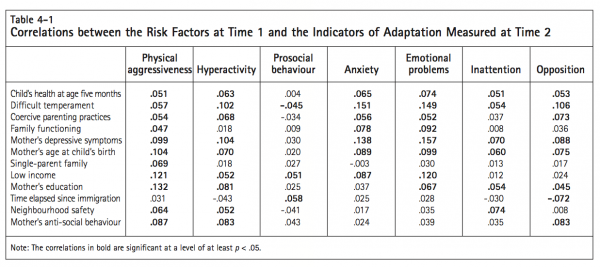
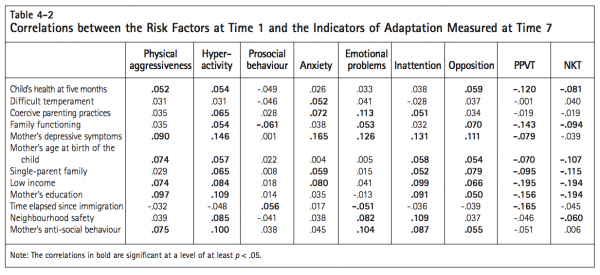
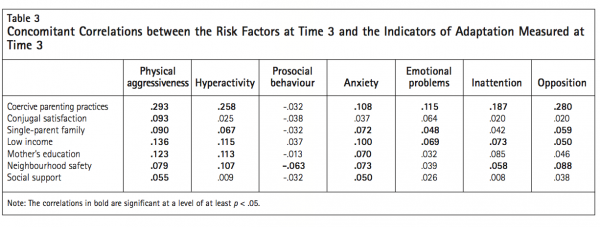
Christa Japel is a professor in the Faculty of Education, Department of Special Education and Training, at the Université du Québec à Montréal. She is also a member of the team leading the Quebec Longitudinal Study of Child Development (QLSCD).
This publication was produced under the direction of Sarah Fortin, Research Director, IRPP. The manuscript was translated by Joan Irving, copy-editing was by Jane Broderick, proofreading was by Zofia Laubitz, production was by Chantal Létourneau, art direction was by Schumacher Design and printing was by AGL Graphiques.
Copyright belongs to IRPP. To order or request permission to reprint, contact:
IRPP
1470 Peel Street, Suite 200
Montreal, Quebec H3A 1T1
Telephone: 514-985-2461
Fax: 514-985-2559
E-mail: irpp@nullirpp.org
All IRPP Choices and IRPP Policy Matters are available for download at irpp.org.
This publication is a translation of Japel, Christa. 2008. “Risques, vulnérabilité et adaptation : les enfants à risque au Québec.” Choix IRPP, vol. 14, no. 8.
To cite this document:
Japel, Christa. 2008. “Factors of Risk, Vulnerability and School Readiness among Preschoolers: Evidence from Quebec.” IRPP Choices 14 (16).